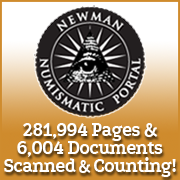
About UsThe Numismatic Bibliomania Society is a non-profit organization devoted to the study and enjoyment of numismatic literature. For more information please see our web site at coinbooks.org SubscriptionsThose wishing to become new E-Sylum subscribers (or wishing to Unsubscribe) can go to the following web page link MembershipThere is a membership application available on the web site Membership Application To join, print the application and return it with your check to the address printed on the application. Membership is only $20 to addresses in the U.S., $25 for First Class mail, and $30 elsewhere. For those without web access, write to: Terry White, Treasurer
AsylumFor Asylum mailing address changes and other membership questions, contact Terry at this email address: terrywhite5475@yahoo.com SubmissionsTo submit items for publication in The E-Sylum, just Reply to this message, or write to the Editor at this address: whomren@gmail.com BUY THE BOOK BEFORE THE COIN |
- WAYNE'S WORDS: THE E-SYLUM JUNE 5, 2016
- SELECTIONS FROM Kolbe & Fanning’S SALE #142
- BALDWIN'S NUMISMATIC LITERATURE SELECTIONS
- WHITMAN RELEASES NEW SEARCH &SAVE COIN BOOKS
- NEW BOOK: CURRENCY, THE POMPEIIANS AND VESUVIUS
- NEW BOOK: LUCKY BUCKS COMIC PLAY MONEY
- BOOK REVIEW: ENCYCLOPEDIA OF COIN AND MEDAL TECHNOLOGY
- BOOK REVIEW: THE MILLIONAIRE AND THE BARD
- THE EARLY HISTORY OF THE NUMISMATIST
- NEWMAN PORTAL SCANS KELLY’S COINS AND CHATTER
- THE MYSTERIOUS MRS. MARSHALL
- NATIONAL COIN COLLECTORS ASSOCIATION MONOGRAPHS
- NOTES FROM E-SYLUM READERS: JUNE 5, 2016
- BURDETTE GARNER JOHNSON (1885-1947)
- BUILDING THE JOSIAH K. LILLY COLLECTION
- MYSTERY NUMISMATIST: CARLING GRESHAM
- BILL PROPOSES SAINT-GAUDENS NATIONAL ARTS PARK
- ROYAL CANADIAN MINT ARTIST GLEN SCRIMSHAW
- COINWEEK POGUE IV AUCTION ANALYSIS
- SILVER ROUNDS FEATURE HOBO NICKEL DESIGNS
- TRADE DOLLARS IN OREGON 1875-1876
- CIVIL WAR TOKEN SCRIP MATES
- HALL OF FAME FOR GREAT AMERICANS MEDALS
- THE PHOTOPLAY MAGAZINE MEDAL OF HONOR
- 1804 WILLIAM LANGMUIR COUNTERMARK SOUGHT
- 2016 DAMIN CONFERENCE VISITS SAN FRANCISCO
- KENT POLICE SEIZE MEDIEVAL COINS IN RAID
- THE AFGHANISTAN CAMPAIGN MEDAL
- THE YUNNAN RATION GOLD COIN
- ROYAL MINT STRIKES GOLD KICK-OFF COIN
- MORE CHOPMARKS ON MODERN U.S. PAPER MONEY
- MILITARY MONEY FROM TNE 2016 VALKENBURG FAIR
- STACKS-BOWERS TO AUCTION MAJOR MPC COLLECTION
- MORE ON COLLECTING ZERO RUPEE NOTES
- SWEDEN LEADS RACE TO CASHLESS SOCIETY
- MIRROR-FILLED BOOKSTORE SEEMS NEVER-ENDING
- FEATURED WEB PAGE: COINS OF THOMAS SPENCE
Click here to access the complete archive
To comment or submit articles, reply to whomren@gmail.com
WAYNE'S WORDS: THE E-SYLUM JUNE 5, 2016
Please welcome our newest advertiser, Dix Noonan Webb Ltd of London, who have a sale coming up this week (June 8-9, 2016).
New subscribers this week include: Eric Hodge. Welcome aboard! We now have 1,976 subscribers.
On Friday the American Numismatic Society tweeted:
ANS associate John Graffeo has just scanned over 100,000 pages of our auction catalogues for the Internet Archive.
Wow! Thanks, John! This effort is part of the Newman Numismatic Portal project. As seen in the page counter to the right, the NNP now has over 281,000 pages of numismatic content. See two articles in this issue for the latest NNP additions.
This week we open with some interesting selections from Kolbe & Fanning's upcoming sale, some new books, two reviews, and the early history of The Numismatist.
Other topics this week include Kelly's Coins and Chatter, the mysterious Mrs. Marshall, NCCA monographs, Burdette Johnson, Josiah Lilly, Carling Gresham, Trade Dollar circulation, Civil War token "scrip mates", the Afghanistan Campaign medal and a frozen image of coin circulation in Pompeii.
To learn more about Lucky Bucks play money, Robinson &Ballou cardboard scrip, Hall of Fame of Great Americans medals, the Photoplay Magazine Medal of Honor, the William Langmuir countermark, Military Payment Certificates, nighthawking, and transgendered Georgie, read on. Have a great week, everyone!
Wayne Homren
Editor, The E-Sylum
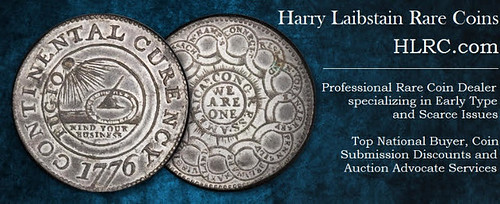
SELECTIONS FROM Kolbe & Fanning’S SALE #142
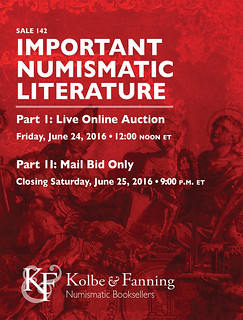 As announced last week, Kolbe & Fanning will be holding our 142nd sale of important numismatic literature on June 24 and 25, 2016. It is a
two-part sale, with a live online component to the first 380 lots, and with the second part (over 600 lots) being a traditional mail-bid sale.
As announced last week, Kolbe & Fanning will be holding our 142nd sale of important numismatic literature on June 24 and 25, 2016. It is a
two-part sale, with a live online component to the first 380 lots, and with the second part (over 600 lots) being a traditional mail-bid sale.
It’s natural, when promoting a sale, to focus on the higher-priced items: landmark rarities, exquisite bindings and so on. It occurs to
us, though, that there are a number of items in this sale that are just plain fun: and since hobbies are supposed to be enjoyable (no
matter how seriously we may take them), we thought we’d focus some attention on a few of these lots:
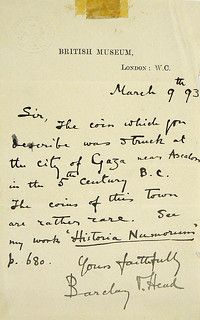
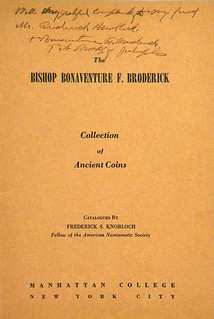
Lots 72 and 93
--Lot 72: a handwritten letter, signed, by Barclay V. Head, dated 1893 on British Museum notepaper. The letter cites a passage in his Historia Numorum, the first edition of which was published just six years before.
--Lot 93: a copy of Frederick S. Knobloch’s very scarce 1942 catalogue of the Bishop Bonaventure F. Broderick collection of ancient coins, inscribed to the author by Bishop Broderick.
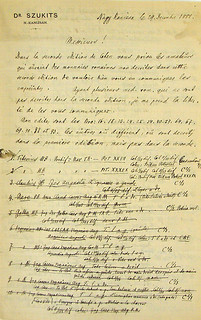
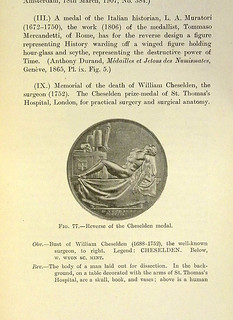
Lots 142 and 176
--Lot 142: Félix Feuardent’s copy of Alphonse de Schodt’s 1879 listing of unpublished Roman coins, with handwritten inventories of additional unpublished coins from Heinrich Dressel and Ferdinande Szukits laid in.
--Lot 176: the third (and best) edition of Frederick Parke Weber’s famous Aspects of Death, a macabre compendium with a surprising amount of numismatic content, by one of the doctors treating Joseph Merrick, the “Elephant Man.”
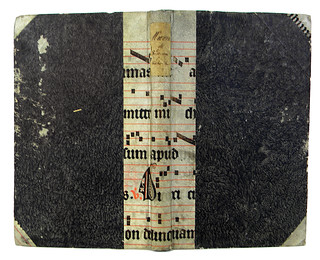
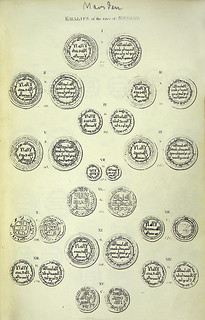
Lots 180 and 231
--Lot 180: a copy of Johann Friedrich Wurm’s 1820 work on ancient metrology, with the binding’s spine backed in vellum musical manuscript and all page edges dyed blue (which, along with green edges, was a mostly 19th-century German fashion that we rather like).
--Lot 231: a possibly unique two-volume independent production comprising a plate key to Marsden’s Numismata Orientalia Illustrata.
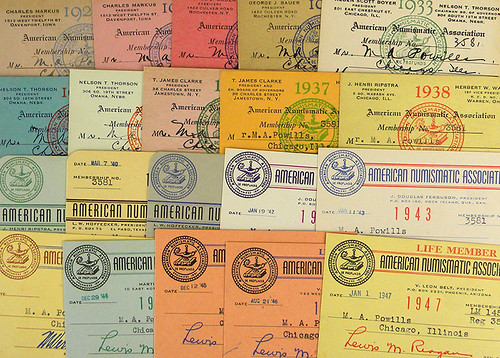
Lot 286
--Lot 268: a complete run of American Numismatic Association membership cards from 1929 to 1947, all issued to M.A. Powills.
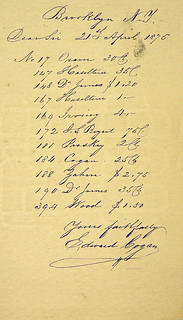
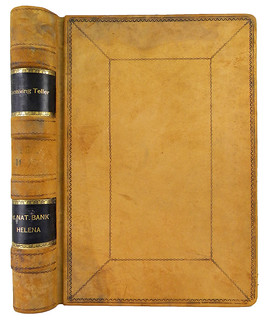
Lots 284 and 293
--Lot 284: a wonderful handwritten postcard from Edward Cogan to J.N.T. Levick, reporting on prices realized at Cogan’s Mar. 1-2, 1875 auction.
--Lot 293: a very large (51.5 by 40.5 by 6.5 cm) bank register of the receiving teller of the First National Bank of Helena for 1890.
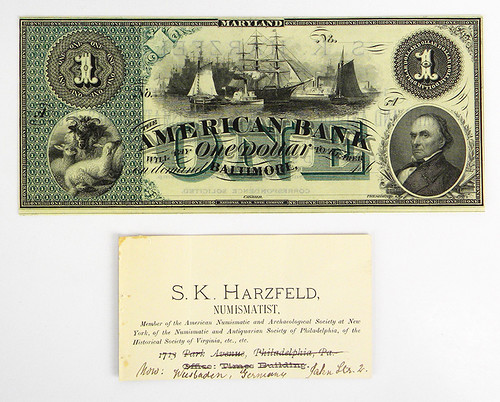
Lot 300
--Lot 300: a fantastic promotional piece for S.K. Harzfeld, printed on the blank verso of a National Bank Note Company sample.
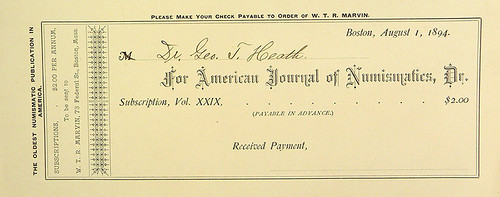
Lot 301
--Lot 301: a subscription form sent to Dr. George Heath, founder of the American Numismatic Association, calling on him to renew his subscription for the 1894-95 volume of the American Journal of Numismatics.
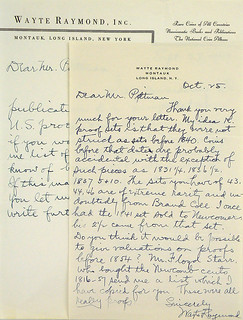
Lot 351
--Lot 351: two handwritten letters from Wayte Raymond to John J. Pittman on the subject of proof coins.
And that’s just in Part I of the sale. Few of the above lots will be in the running for Star of the Show as far as prices realized goes, but they all get to the heart of why we collect: because it’s interesting and intellectually stimulating and just plain fun.
For more information on the sale, go to numislit.com, where a PDF of the entire catalogue can be downloaded and where you may connect to our custom online bidding platform for Part I of the sale. Printed catalogues have been mailed to established clients. Feel free to email David Fanning at df@numislit.com with any questions. We look forward to your participation.
BALDWIN'S NUMISMATIC LITERATURE SELECTIONS
Svoronos On Crète
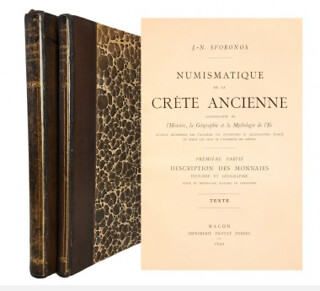
Svoronos, J.N. Numismatique de la Crète Ancienne accompagnee de l’Histoire, la Geographie et la Mythologie de l’Ile. Macon, 1890. Complete in two parts. Quarto. (4), ix, (1), 358; 35 fine plates. Both parts handsomely bound in brown morocco and marbled boards. Spine ruled, decorated and lettered direct in gilt. Contents a trifle browned as is usual but clean and otherwise bright. The plates in a similar state and well preserved having been bound in on hinges. The last plate with a photograph of the obverse and reverse of a Hadrian bronze neatly pasted in.
The standard reference for the series. Clean, bright and in a handsome contemporary binding. A very fine copy. Seldom offered.
Clain-Stefanelli 2581*; Daehn 4437; Kroh 50 (four stars), ‘This study, as opposed to the BMC, attempts to be a corpus of all known types and is still utilized as such by most researchers… Very rare.’
For more information, or to order, see:
A Beautiful Copy Of Svoronos On Crète
(www.baldwin.co.uk/a-beautiful-copy-of-svoronos-on-crete.html)
The Kress Collection Of Renaissance Bronzes And Medals
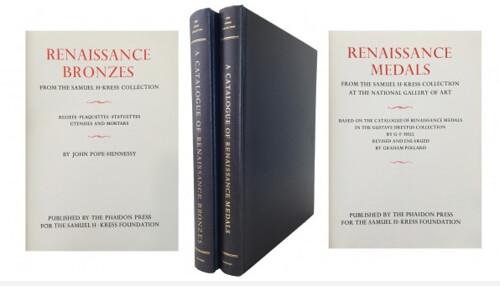
Hill, G. &Pollard, G. &Pope-Hennessey, J. Renaissance Bronzes from the Samuel H. Kress Collection. Reliefs, Plaquettes, Statuettes, Utensils and Mortars. With; Renaissance Medals from the Samuel H. Kress Collection at the National Gallery of Art based on the Catalogue of Renaissance Medals in the Gustave Dreyfus Collection. London, 1965 &1967. 4to. viii, 333, (3), 616 illustrations; x, 309, (1); 136 plates. Both volumes casebound in the original blue cloth. Minimal wear.
Important references. Clain-Stefanelli 14289*
For more information, or to order, see:
Both Volumes Of The
Famous Kress Collection Of Renaissance Bronzes And Medals
(www.baldwin.co.uk/both-volumes-of-the-famous-kress-collection-of-renaissance-bronzes-and-medals.html)
To read the complete article, see:
www.baldwin.co.uk/catalog/category/view/id/321

WHITMAN RELEASES NEW SEARCH &SAVE COIN BOOKS
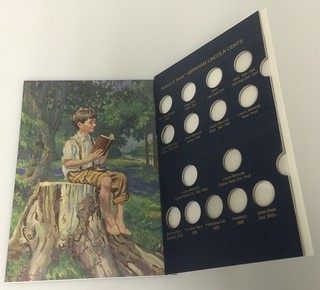 Whitman Publishing announces the release of the first three volumes in a new series of combination book-albums, trademarked under the name
Search &Save. Each volume consists of a 64-page book bound with a Whitman Classic Coin Album page for storing and displaying a coin
collection. The Search &Save volumes are intended for beginning to intermediate hobbyists, and as a fun way to introduce newcomers to active coin
collecting. The first three books cover Lincoln cents, nickels, and State quarters. Each retails for $9.95 and is available from booksellers and
hobby shops nationwide, and online (including at www.Whitman.com).
Whitman Publishing announces the release of the first three volumes in a new series of combination book-albums, trademarked under the name
Search &Save. Each volume consists of a 64-page book bound with a Whitman Classic Coin Album page for storing and displaying a coin
collection. The Search &Save volumes are intended for beginning to intermediate hobbyists, and as a fun way to introduce newcomers to active coin
collecting. The first three books cover Lincoln cents, nickels, and State quarters. Each retails for $9.95 and is available from booksellers and
hobby shops nationwide, and online (including at www.Whitman.com).
The Whitman Classic® Coin Album page has protective plastic slides that are inserted on each side of the page’s openings, holding coins firmly in place while allowing both obverse and reverse to be displayed. Many of the Search &Save coins can be collected from circulation. Others require some hunting at local coin shops, online, or at a coin show.
“Our goal with these Search &Save books is for the reader to learn about each coin, and to enjoy the fun of building their own personalized collection,” said Whitman publisher Dennis Tucker. “When they’re done, they’ll not only have a valuable coin collection, but they’ll be able to tell each coin’s story and share them with their friends and family.”
Search &Save: Abraham Lincoln Cents—From Birth to Bicentennial, and Beyond features a colorfully illustrated chapter on the life of Abraham Lincoln, along with chapters on the Wheat cent, the Memorial cent, Bicentennial cents of 2009, the Union Shield cent, and other Lincoln coins and collectibles. A final chapter describes how to collect Lincoln cents, and the book’s album page provides openings for 15 different coins of different designs and alloys. These include the series’ first year of issue (1909); the Wheat cent of 1909 to 1958; the 1943 steel cent; the “cartridge case” cents of 1944 to 1946; bronze, brass, and copper-plated zinc Lincoln Memorial cents, in circulation-strike and Proof formats; the four special designs of the 2009 bicentennial of Lincoln’s birth; and today’s Union Shield cent, minted since 2010.
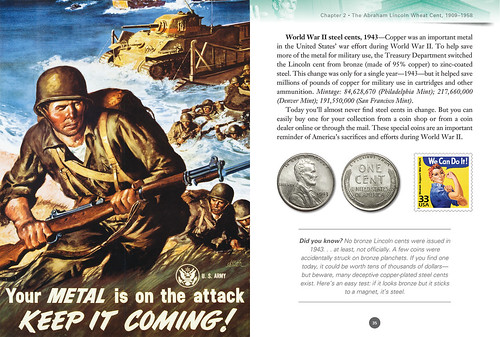
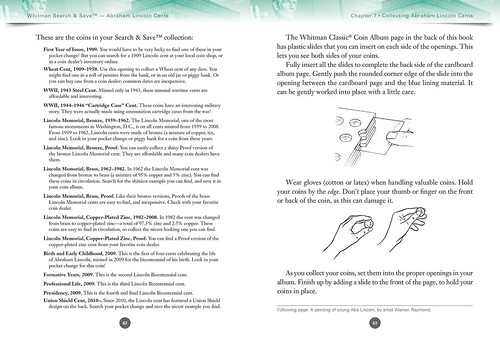
Search &Save: Nickels—150 Years of United States Five-Cent Coins, 1866 to 2016 and Beyond includes an introduction to America’s early silver half dimes and later nickel five-cent coins. Other chapters describe Shield nickels, Liberty Head nickels, Buffalo nickels, and Jefferson nickels, including those of the Westward Journey series honoring the Lewis and Clark exploration of the Louisiana Purchase. It explores hobby topics such as how to grade nickels. The book’s album page allows the collector to display 16 coins of different types and varieties, ranging from the earliest Shield nickels to today’s Jeffersons.
Search &Save: State Quarters—Including the District of Columbia and U.S. Territories tells the stories of each of the 56 quarters minted from 1999 to 2009, with facts about each state and territory; significance of the images on the coins; and colorful illustrations of America’s people, wildlife, and landscapes. The book’s album page includes openings for 11 coins, allowing the reader to collect a favorite design from each of the years of issue. This volume is unique in that every coin studied can be easily collected from pocket change and by searching bank rolls.
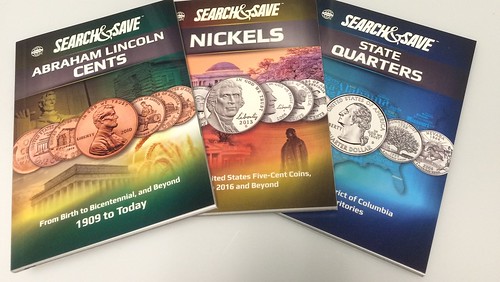
Additional Search &Save volumes (on dimes and quarters, half dollars, and dollar coins) will debut in November 2016.
Because Whitman Publishing is the Official Supplier of the American Numismatic Association, ANA members receive 10% off the Search & Save books when purchasing directly.
For more information, or to order, see:
www.whitman.com
NEW BOOK: CURRENCY, THE POMPEIIANS AND VESUVIUS
Georges Depeyrot writes:
Lastest volume: Moneta # 193, G. Depeyrot, Currency, the Pompeiians and Vesuvius, Wetteren, 2016, 204 p., ISBN 978-94-91384-61-5 see http://www.moneta.be Moneta published in the Collection Moneta studies devoted to numismatics and monetary economy (all periods, all regions, and all languages).
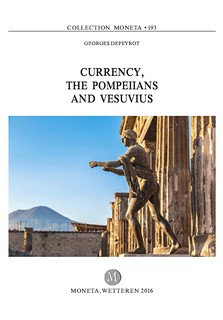 The analysis of Roman coin circulation is generally based on hoards and coin finds. They reflect two different aspects of the movement of
coins. The former are the result of the careful selection of coins according to metal, date of issue, conservation; the latter are the result of
haphazard losses of petty coins that nobody wanted to spend time to recover.
The analysis of Roman coin circulation is generally based on hoards and coin finds. They reflect two different aspects of the movement of
coins. The former are the result of the careful selection of coins according to metal, date of issue, conservation; the latter are the result of
haphazard losses of petty coins that nobody wanted to spend time to recover.
Pompeii is a unique case. The sudden eruption of Vesuvius on October 24th, 79, stopped life in the city. At this moment (1 pm), a large part of the population was working outside the town. While the inhabitants of Herculaneum had enough time to try to escape from the city, Pompeii was quickly covered with pumice that made it impossible to return to the city or obstructed escape from the houses that the first pyroclastic flows very rapidly submerged. Pompeii is a unique opportunity to see a frozen image of coin circulation, even if the immediate looting of the ruins may have disturbed the remains.
During the extensive excavations conducted in the 18th and 19th centuries a huge number of coins were found, but unfortunately they were largely mixed together or lost. However, the diaries of the excavations give many imperfect mentions of coin finds. Nevertheless a collection of all these imprecise descriptions offers a picture of the coins and the city.
The main purpose of this study is to understand the reality of currency distribution. It is time to try to analyse how many coins were found and how many coins were in the hands of the population. What was the reality of the coin supply in such an Italian town? How many coins had each Pompeiian, by metal, and by regio. What was the composition of their savings? When did they segregate coins according to metal? What was the relationship between the monetary stock and prices? What was the role and the level of intervention of the bankers in comparison with the precious hoards and savings of the rich Pompeiians? Can we deduce from the coin finds the social position of the inhabitants of the various villae?
MONETA 193, 204 pages 75 euros contents ISBN 978-94-91384-61-5
For more information, or to order Moneta #193, see:
Moneta 193: Currency, the Pompeiians and Vesuvius
(www.moneta.be/volumes/moneta_193.htm)
Georges adds:
Moneta (www.moneta.be) is now completely changing its system of communication. If you want to receive a mail informing you of new publications, of new promotions or discounts, leave your email address on http://www.moneta.be. Now there is a -20 % / -25 % discount on all the volumes see details also on the page http://www.moneta.be
NEW BOOK: LUCKY BUCKS COMIC PLAY MONEY
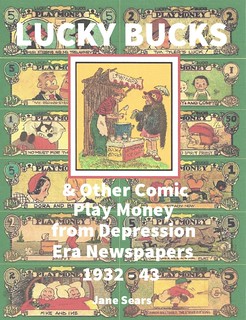 After collecting Lucky Bucks and other "play money" since 1980, collector/author Jane Sears wrote "Lucky Bucks &Other
Comic Play Money from Depression Era Newspapers 1932-43" to share with others her collection and items from collections of some of her
friends.
After collecting Lucky Bucks and other "play money" since 1980, collector/author Jane Sears wrote "Lucky Bucks &Other
Comic Play Money from Depression Era Newspapers 1932-43" to share with others her collection and items from collections of some of her
friends.
Most collectors have never heard of Lucky Bucks play money which appeared in the comics sections of newspapers in 1932 and 1933. This
231 page book tells the stories of Lucky Bucks and other similar items from the Great Depression. Printed in color, it has over 1500
illustrations including over 1000 Lucky Bucks.
Featured on the Lucky Bucks are characters from comic strips of the day. Include are Mickey Mouse, Blondie, Barney Google, Felix the Cat, Skippy, Popeye and many others. Readers are taken back in time to learn about the early days of many comic strips, the characters featured in them and how Lucky Bucks were used in commerce and as collector's items.
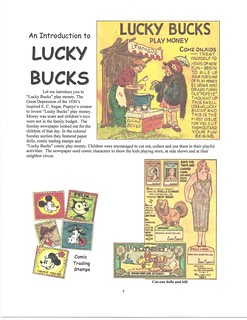
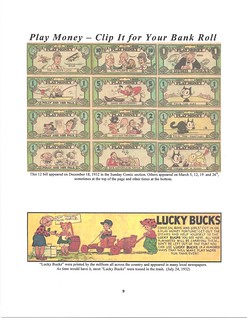
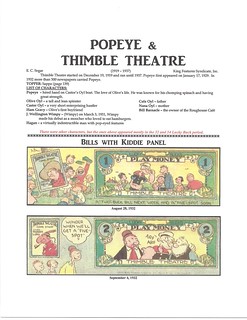
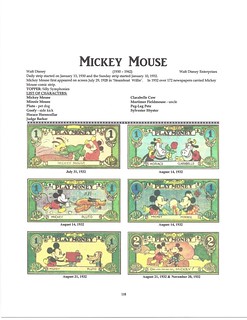
Retail price of the book is $ 59.95. E-Sylum readers in the United States may purchase the book at a special price of $ 52.95 Orders may be sent to Jane Sears, 9323 Waltham Woods Road, Baltimore, Maryland 21234. Questions about the book may be sent to MaryJaneSears1@Gmail.com .
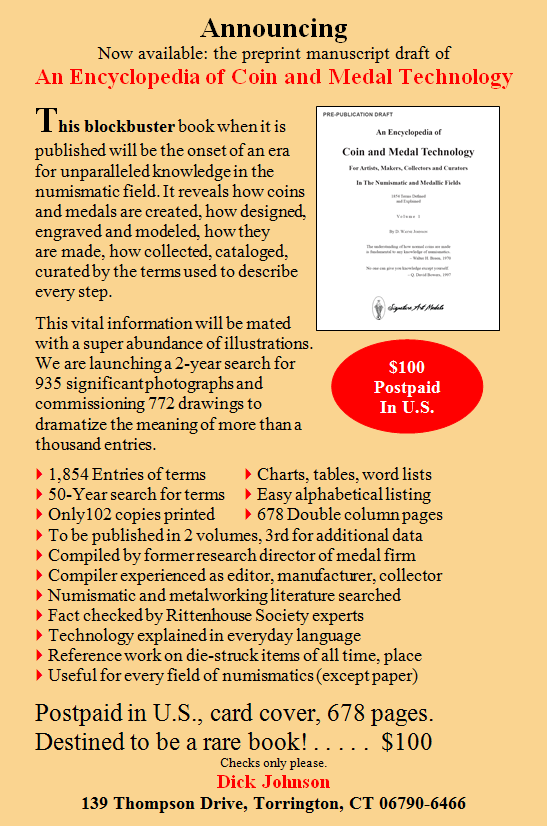
BOOK REVIEW: ENCYCLOPEDIA OF COIN AND MEDAL TECHNOLOGY
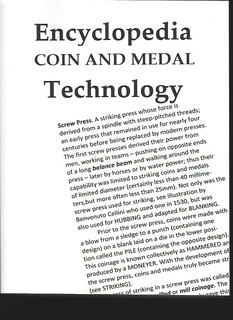 The numismatic world has recently been abuzz over the promise of a definitive new reference work covering the art and technology of coin
and medal making. All too few chroniclers have attempted to explain and describe the intricacies of how the objects of our special interest are
produced, much less catalog the jargon that has been held, often rather secretly, by those who ply this ancient art.
The numismatic world has recently been abuzz over the promise of a definitive new reference work covering the art and technology of coin
and medal making. All too few chroniclers have attempted to explain and describe the intricacies of how the objects of our special interest are
produced, much less catalog the jargon that has been held, often rather secretly, by those who ply this ancient art.
I recently spent some pleasant time getting acquainted with Dick Johnson’s incredible new book project. This looks like the work of a lifetime and is bound to be an indispensable reference for every serious numismatist. I cannot say enough good things about it, even if it is still in an unfinished stage. I am convinced that when replete with illustrations and whatever else may be added, it will set a new standard for encyclopedic publications.
Johnson’s Encyclopedia of Coin and Medal Technology is a hefty 8.5” x 11” tome with 671 pages (at this time) and is packed with “everything anyone would ever need to know” about the technical side of how these items are made, and what they should properly be called when we write or speak of them. The author has done an extraordinary job capturing so much information, and presenting it in a useful form. It is obviously a labor of love reflecting a lifetime of interest in his chosen field.
Although medals are not my forte, I know that this reference is one that will be used frequently and be an essential addition to any home library. I felt honored and very pleased to receive an early copy of Dick’s manuscript for review and comments. I have no doubt that this work, replete with additional observations from his many friends and specialists will become a classic.
To read the earlier E-Sylum articles, see:
NEW BOOK: ENCYCLOPEDIA OF COIN AND MEDAL TECHNOLOGY
(www.coinbooks.org/esylum_v19n17a05.html)
BOOK REVIEW: ENCYCLOPEDIA OF COIN AND MEDAL TECHNOLOGY
(www.coinbooks.org/esylum_v19n20a05.html)
BOOK REVIEW: THE MILLIONAIRE AND THE BARD
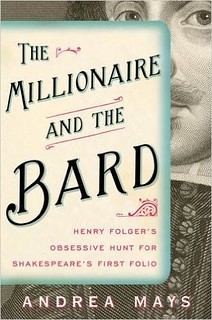 I have recently read an outstanding book that I think NBS members will appreciate, in spite of its non-numismatic content.
I have recently read an outstanding book that I think NBS members will appreciate, in spite of its non-numismatic content.
The Millionaire and the Bard, Henry Folger’s Obsessive Hunt for Shakespeare’s First Folio, by Andrea Mays, is the true account of Standard Oil executive Henry Folger and his maniacal pursuit of the Shakespeare First Folio, and all things Shakespeare (Shakespeariana).
The book begins with a biographical look at William Shakespeare’s life, and how, after his death, two of his colleagues decided his plays should be preserved – culminating in the publishing of the First Folio. The First Folio (published 1623) is the very birth of the writings of Shakespeare as we know them today.
Mays’ book is detailed in all the things bibliophiles cherish; early book manufacturing, early book publishing, reprints, addenda, counterfeits; it describes years of lull and public indifference toward the publication, then the catch-fire excitement it ultimately ignited.
Cut to almost 300 years later and one rich man who deeply desires to own all extent copies of the First Folio. Again, what is chronicled are all things prized by bibliophiles; research, cataloging, pursuit, negotiating, auctions, triumphs and failures, secrecy and intrigue. There is also the unsavory rivalries, back-biting, and jealousy.
Did Henry Folger manage to collect all copies of the First Folio? I recommend you read the book to find out.
For more information, or to order, see:
The Millionaire and the Bard: Henry
Folger’s Obsessive Hunt for Shakespeare’s First Folio
(http://books.simonandschuster.com/The-Millionaire-and-the-Bard/Andrea-Mays/9781439118252)

THE EARLY HISTORY OF THE NUMISMATIST
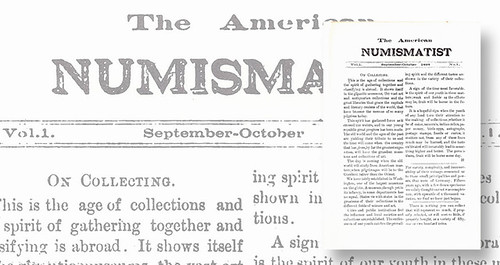
In 2016 the American Numismatic Association celebrates its 125th anniversary, chronicled by the ANA’s official journal, The Numismatist. But, as the Grateful Dead would sing, “what a long, strange trip it’s been” for The Numismatist: it wasn’t always the ANA’s official journal; it was owned at various times by three different private individuals; and it didn’t even begin with that name.
The story starts downriver from Detroit, with Dr. George Heath, physician and mayor of Monroe, Mich. A coin collector and “vest pocket” dealer, Heath issued, in September 1888, a periodical dubbed The American Numismatist to sell his duplicates. By its second issue, in November, “American” disappeared from the masthead. A defunct numismatic magazine by that name had been published in Paterson, N.J.; perhaps Heath sought to avoid confusion, perhaps he just liked the shorter title better, but he never explained the alteration.
Heath enthusiastically filled The Numismatist’s pages with readable stories.
In the February 1891 issue, he asked: “Whats the matter of having an American Numismatic Association? ... Would it be practicable?” Favorable responses abounded; in the June number, he nominated a slate of officers for the association. The doctor’s choice for secretary, Charles T. Tatman, was the coin columnist for a nationally distributed youth newspaper named Plain Talk, which Heath suggested as the “official organ” of the ANA. Heath’s recommendation was never formally ratified, but Tatman reported ANA news in his column until the summer of 1892, when he left for a European vacation. He resigned, as of June 15, both as ANA secretary and as Plain Talk’s coin columnist, and The Numismatist became the ANA’s official journal by default.
Heath was a hands-on editor, personally printing every issue through 1893 on his own printing press, and always publishing The Numismatist in the best interests of the ANA. Death came for the doctor June 16, 1908, and Farran Zerbe swooped in a month later to buy The Numismatist from Heath’s widow. Zerbe, of Tyrone, Pa., was also the sitting president of the ANA, and questions quickly arose about the appropriateness of his involvement in ANA politics while personally owning its official publication. A bitterly contested election in 1909 worsened the conflict.
As 1910 wore on, The Numismatist had been the ANA’s journal for nearly 20 years, but never had the ANA owned or controlled it. Stepped forth W.W.C. Wilson, a Montreal numismatist, who bought the magazine from Zerbe in November 1910, and generously donated it to the ANA. Ironically, it took a Canadian to resolve the conflict of interest bedeviling the American Numismatic Association. Even more ironically, the ANA’s top award is named in Zerbe’s honor, while Wilson, the ANA’s greatest benefactor, is honored not at all in Colorado Springs, Colo.
Collectors benefit from the long, strange trip of The Numismatist, for extensive runs of the magazine can be purchased relatively inexpensively: 1911 to date for about $1,000, and 1894 to date for less than $3,000. The first six volumes, personally printed by Dr. Heath, are another story: a mere dozen complete sets can be definitively traced in individual and institutional libraries, and is likely to top $30,000 on those rare occasions when offered at public auction. Fortunately, a 1963 reprint of the first six volumes goes for about $250.
To read the complete article, see:
Before it became the ANA's official
journal, it was something else: Numismatic Bookie
(www.coinworld.com/news/us-coins/2016/06/evolution-of-ana-numismatic-journal.html)
THE BOOK BAZARRE
NEWMAN PORTAL SCANS KELLY’S COINS AND CHATTER
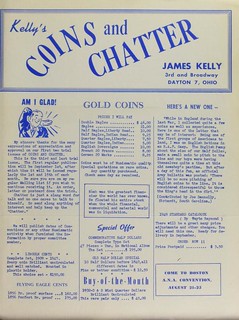 The Newman Numismatic Portal has scanned a comprehensive run of Kelly’s Coins and Chatter. The house organ of Dayton, OH
dealer Jim Kelly, Coins and Chatter follows the publication model established in the 19th century by Ebenezer Mason and other dealers – coins
for sale, occasional graphics to add visual appeal, all interspersed with numismatic gossip and bits of hard news.
The Newman Numismatic Portal has scanned a comprehensive run of Kelly’s Coins and Chatter. The house organ of Dayton, OH
dealer Jim Kelly, Coins and Chatter follows the publication model established in the 19th century by Ebenezer Mason and other dealers – coins
for sale, occasional graphics to add visual appeal, all interspersed with numismatic gossip and bits of hard news.
These publications presaged the general interest periodicals of the mid-20th century (Coin World and others) and demonstrated an appetite for numismatic information outside of terse coin listings. The serial numbering of Coins and Chatter is an unsolved mystery to us, and we invite readers to help fill gaps or clarify our ordering.
Link to Kelly’s Coins and Chatter on NNP:
https://nnp.wustl.edu/library/publisherdetail/512348
Link to all house organs on NNP:
https://nnp.wustl.edu/library/periodicals?Tag=House%20Organ
THE MYSTERIOUS MRS. MARSHALL
The Mysterious Mrs. Marshall: An Early American Numismatist
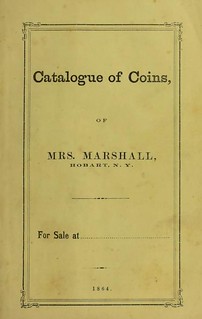 Listed in Attinelli, for the year 1864, “Mrs. Marshall” has long been known as a numismatic name, but her precise identity has eluded
researchers. “Mrs. Marshall” has heretofore been associated with a lone catalog from 1864, and even the catalog itself raises more questions than it
answers. This document recently came across the scanners at the Newman Numismatic Portal (courtesy of Dave Hirt). It lists an extensive collection of
ancient, foreign, and U.S. coins, but it is unclear whether this is a fixed price list or an auction catalog.
Listed in Attinelli, for the year 1864, “Mrs. Marshall” has long been known as a numismatic name, but her precise identity has eluded
researchers. “Mrs. Marshall” has heretofore been associated with a lone catalog from 1864, and even the catalog itself raises more questions than it
answers. This document recently came across the scanners at the Newman Numismatic Portal (courtesy of Dave Hirt). It lists an extensive collection of
ancient, foreign, and U.S. coins, but it is unclear whether this is a fixed price list or an auction catalog.
To the rescue comes John Lupia, who has provided a helpful biography of Mrs. Marshall at his Numismatic Mall site. Briefly summarizing, Francis Maria Keeler (1810-1879) married Dr. Robert S. Marshall in 1832 and the two settled in Hobart, NY. The doctor, bitten by “gold fever,” traveled to California where he died in 1850. Mrs. Marshall appears to have continued the collection, as it contained pieces struck after 1850.
Dave Hirt, in 1996, noted that “Mrs. Marshall” was listed as a buyer in a priced and named copy of Bangs’ J.N.T. Levick sale (1865). This alone qualifies Mrs. Marshall as one of the earliest female numismatists in the United States, and to that we may be able the title of “coin dealer” as well, although this is less clear. While the cover of the Marshall catalog indicates “for sale,” Lupia raises the possibility that the catalog was prepared in conjunction with an exhibit at the annual Delaware County Agricultural Fair, where it is known that she regularly exhibited.
Link to John Lupia’s biography of Mrs. Marshall:
https://sites.google.com/a/numismaticmall.com/www/numismaticmall-com/marshall-frances-maria-keeler
Link to the Mrs. Marshall catalog on the Newman Portal:
https://nnp.wustl.edu/library/book/515883
Link to Dave Hirt’s Asylum article on Mrs. Marshall:
https://nnp.wustl.edu/library/book/417?page=44
To read the earlier E-Sylum article, see:
WAYNE'S NUMISMATIC DIARY: MARCH 31, 2016: PART 1
(www.coinbooks.org/esylum_v19n14a21.html)

NATIONAL COIN COLLECTORS ASSOCIATION MONOGRAPHS
Regarding my question about monographs published by the National Coin Collectors Association (NCCA), Mark Verbeck of Lake Bluff, Illinois writes:
I can supply only a incomplete answer concerning the National Coin Collectors Association. I have Monograph #3, dated June 1991.
Title: LIBERTY SEATED COINAGE
Subtitle: AN INTRODUCTION TO THE COLLECTING OF LIBERTY SEATED HALF DIMES, DIMES, 20-CENT PIECES, QUARTERS, HALF DOLLARS, AND DOLLARS [this also all-caps, but in smaller font]
Text is numbered pp. 2--15. Back cover is blank.
As you probably recall, Mr. Atkinson was based in Murphysboro, Illinois, close to Southern Illinois University in Carbondale.
Pete Smith writes:
NCCA (National Coin Collectors Association) offered three monographs in The U. S. Coin Collector, Issue 6, July 1991.
Monograph #1 NUMISMATIC LITERATURE: A BIBLIOGRAPHY OF WORKS NECESSARY FOR THE STUDY AND COLLECTING OF U. S. COINS. (10/90)
Monograph #2 EARLY SILVER COINAGE: AN INTRODUCTION TO THE COLLECTING OF FLOWING HAIR, DRAPED BUST, AND CAPPED BUST SILVER COINS. (2/91)
Monograph #3 LIBERTY SEATED COINAGE: AN INTRODUCTION TO THE COLLECTING OF LIBERTY SEATED HALF DIMES, TWENTY-CENT PIECES, QUARTERS, HALF DOLLARS, AND DOLLARS. (6/91)
Each was offered to members at $3.00 and to non-members at $5.00.
Thanks also to Mike Paradis who located a listing in David Sklow's Literature Sale #9, Lot 91:
National Coin Collectors Association. NUMISMATIC LITERATURE: A BIBLIOGRAPHY OF WORKS APPROPRIATE FOR THE STUDY AND COLLECTING OF U.S. COINS – MONOGRAPH #1. Murphysboro, IL. 1990. [18pp. no pagination], single sheets, housed in clear plastic report folder. A very useful tool for aiding collectors of U.S. coinage; listings of books include descriptions and important notes with comments; Fine. (40.00)
To view the ANS DONUM records, see:
Results of search for 'pb,wrdl: National Coin Collectors Association'
To read the earlier E-Sylum articles, see:
THE NATIONAL COIN COLLECTORS ASSOCIATION
(www.coinbooks.org/esylum_v19n21a10.html) THE NATIONAL COIN COLLECTORS
ASSOCIATION (www.coinbooks.org/esylum_v19n22a08.html)
THE BOOK BAZARRE
NOTES FROM E-SYLUM READERS: JUNE 5, 2016
The Norwebs: American Loyalty
Dave Bowers writes:
Nice issue! The Norwebs were my definition of American royalty. They had the Bratenahl house, mentioned in the latest issue, also a floor (above Henry Luce, founder of Time-Life) in the River House in New York City, and their summer home in Boothbay Harbor, ME.
Emery May Holden Norweb was a wonderful lady, a fine friend, ever since I was a teenager. They wore their 'nobility,' such as it was, gently and mostly privately, without a whisper of ostentation.
My relationship with Emery May Holden Norweb and her son Harry (and his wife Pam), not to overlook Ambassador R. Henry Norweb, are treasures in my memories.
To read the earlier E-Sylum article, see:
NOTES FROM E-SYLUM READERS: MAY 29, 2016 : Norweb Mansion for Rent
(www.coinbooks.org/esylum_v19n22a09.html)
More on the "S S" Counterstamp
Regarding Bruce Smith's question about an "S S" counterstamp on a New Jersey cent, Ed Hohertz writes:
The counterstamp SS is recorded in Merchant and Privately Countermarked Coins by Gregory Brunk 2003.
"p77 Ireland: This is an odd series. While nothing is known about the issuer, the SS countermarked coins are numerous. They also appear on lead counterfeits of various coins.
SS (S-62) Farthing: UK (3)
halfpenny: 1693 UK
Irish halfpenny: 1766
Halfpenny token: UK (1)
French liard: UK
St. Patrick Halfpenny: UK
Russian half denga: 1753
Lead counterfeits: numerous
SS (S-63)
Rev: O K (included above)"
p338 under the category of Regulated Gold Coins (interesting to see that defined later in the same issue of the E-Sylum!!)
"These two coins may not have the same countermark. Only one was noted as being incuse.
S S (Incuse) (S-64) 6400 Reis: 1749 1773"
To read the earlier E-Sylum articles, see:
NOTES FROM E-SYLUM READERS: MAY 29, 2016 : Query: Counterstamped New Jersey Cent
Information Sought (www.coinbooks.org/esylum_v19n22a09.html)
OBSOLETE NUMISMATIC TERMS (www.coinbooks.org/esylum_v19n22a12.html)
1854 Gold Proof Set Connection Sought
Dave Hirt writes:
Some weeks ago John Lupia had a very interesting post on the Kline sale of 1855. I wanted to comment at the time, but my copy of that sale catalog was not in my possession. Now I have it again. I completely agree with John that the owner of that collection is unknown.
I have a suggestion that could be checked out. Lots 249-254 were described as a complete 1854 gold proof set, "beautiful, fresh from the die", which by the way sold for par, (face value). The number of these sets sold was surely very very small. Perhaps mint records would show who the purchaser was.
On Transgendered George
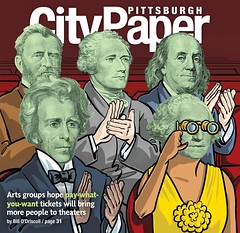 Ron Thompson writes:
Ron Thompson writes:
I loved the cover of the Pittsburgh City Paper. Right with the times. Who would have thought good old George was transgendered Georgie? Maybe the reason he had no children?
To read the earlier E-Sylum article, see:
NOTES FROM E-SYLUM READERS: MAY 29, 2016 : Dead Presidents At the Theatre
(www.coinbooks.org/esylum_v19n22a09.html)
Anti-Semitic Bigotry
Ben Weiss writes:
Regarding the article on Anti-Semitic Banknotes, which refers to the exhibit at the New-York Historical Society on Anti-Semitism 1919-1939, one of the propaganda messages quoted from the anti-Semitic notes: “The aversion of the German people for the Semitic people does not have its cause in the difference of religion...”, is certainly not borne out by the facts.
A recently published review of the history of anti-Semitic medals clearly supports the conclusion that religious art and sacred texts play a prominent role in the propagation of anti-Semitic attitudes. See: Weiss, Benjamin, “Anti-Semitic Bigotry: A Retrospective As Chronicled by Commemorative Medals” , Artwis.com, Kunstpedia Foundation, The Netherlands, 2015.
To read the complete article, see:
Anti-Semitic Bigotry : A Retrospective As Chronicled By Historical Medals
(http://www.historicalartmedals.com/Bigotry.pdf)
To read the earlier E-Sylum article, see:
ANTI-SEMITIC BANKNOTES (www.coinbooks.org/esylum_v19n22a32.html)
THE BOOK BAZARRE
BURDETTE GARNER JOHNSON (1885-1947)
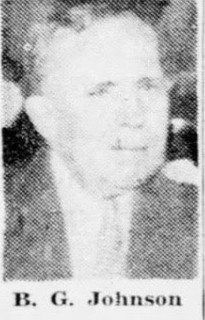 Burdette Garner Johnson (1885-1947) ... was born on January 2, 1885, son of William A. Johnson (1849-1931) and Luella Lou Conway Johnson
(1859-1914) at De Soto, Missouri. While a schoolboy in St. Louis, Missouri, he was a correspondent with the Chapman Brothers buying Roman coins at
age fifteen in September 1900. He is referred to by his late biographer Al Wick as self-educated and is purported to have read a book a day. After
graduating elementary school he moved to his relatives in Columbus, Indiana to work for Prudential as a cashier.
Burdette Garner Johnson (1885-1947) ... was born on January 2, 1885, son of William A. Johnson (1849-1931) and Luella Lou Conway Johnson
(1859-1914) at De Soto, Missouri. While a schoolboy in St. Louis, Missouri, he was a correspondent with the Chapman Brothers buying Roman coins at
age fifteen in September 1900. He is referred to by his late biographer Al Wick as self-educated and is purported to have read a book a day. After
graduating elementary school he moved to his relatives in Columbus, Indiana to work for Prudential as a cashier.
In September 1902 he left his position as cashier of the Prudential Office, Columbus, Indiana, to work in St. Louis for Frank Elmer Ellis (1862-1937), at St. Louis Stamp and Coin (q.v.). Johnson helped Ellis move from 1003 Pine Street to 115 North 11th Street in March 1903. In the April 1903 issue of The Numismatist, Burdette G. Johnson is listed as a new member of the ANA, Member No. 473, who specialized in ancient coins especially Roman.
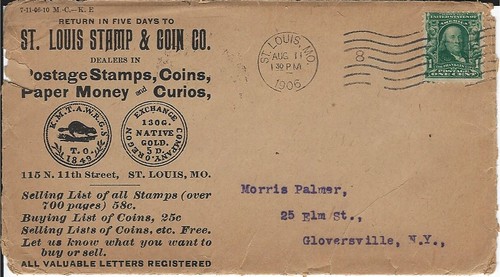
In 1907 he owned St. Louis Stamp &Coin with David A. Sutherland, his partner, whom he bought out in 1908. Johnson maintained Ellis' advertising practice and policy running a new and different full page ad on the inside cover of Philatelic West each month.
He held 36 auction sales from 1902 to 1915. Armin Brand on behalf of the estate of Virgil Michael Brand gave consignments of coins to Johnson... In 1919 he traveled to Great Britain, France, Belgium and Holland to purchase coins.
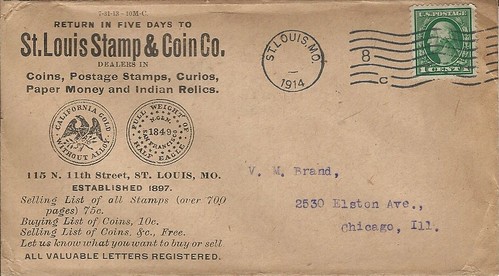
During the Depression a young girl named Mary Cruzan was abandoned by her parents. Johnson took her in and educated her treating her as his own daughter.
In 1933 both Henry Chapman, who was very feeble and infirm at the time, and Burdette Johnson were hired by the Brand brothers to appraise Virgil Brand's gold coin collection. Henry Chapman was slated to appraise first and so was responsible for unwrapping the coins which was a timely process considering the double envelopes and ties Brand kept on each coin. Johnson was to confirm or reevaluate as he deemed appropriate. Apparently the feeble Chapman took too long and Johnson kept yelling to Henry Chapman asking what was taking so long.
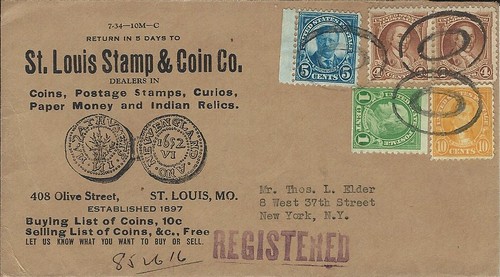
In January 1939 Spink &Son , Ltd., sent Miss M. A. Dunn of Brooklyn two coins, an 1804 and a 1805 U. S. Silver Dollar with the suggestion she show them to Burdette Johnson for authentication. Johnson considered them fakes. They were bought in November of that year by Farran Zerbe. In 1961 M. H. Bolender authenticated them as genuine.
He died on February 24, 1947 on a streetcar en route to his coin shop.
Mary Cruzan (1921-1996), Johnson's virtually adopted daughter inherited the residue of his U. S. Colonial coin stock including a 1782 Libertas Americana, that sold for $20,900 in 1997. The 240 lots of coins were sold posthumously in June 1997 at Christies, New York, and realized $1.1 Million USD. Fifty years after his demise Burdette G. Johnson's legacy to his daughter Mary Cruzan set a record at auction.
He is buried in Valhalla Cemetery, Bel-Nor, St. Louis County, Missouri.
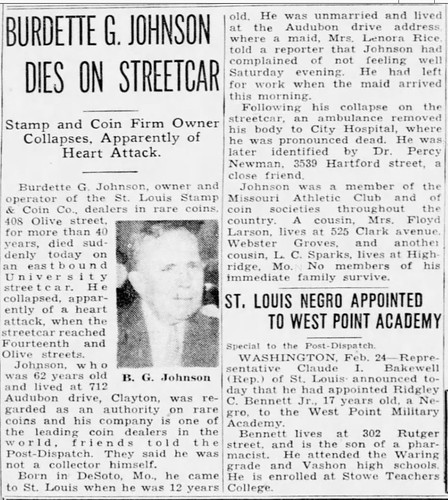
To read the complete article, see:
JOHNSON, BURDETTE GARNER
(https://sites.google.com/a/numismaticmall.com/www/numismaticmall-com/johnson-burdette-g)

BUILDING THE JOSIAH K. LILLY COLLECTION
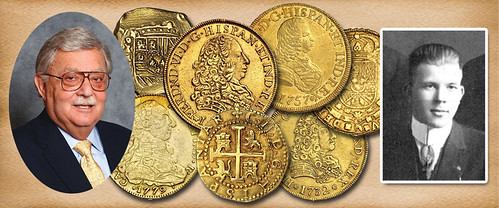
In the spring of 1951, a well-dressed, debonair gentleman came into our shop. He wanted to know if we had any doubloons, from Central and South America to show him. Stack's always maintained a vast and diverse inventory and we took out a few Spanish Colonial gold coins to show him. He introduced himself as Josiah K. Lilly, the chairman of his family's pharmaceutical business, Eli Lilly and Company, headquartered in Indianapolis. He explained he had a passion to learn more about the coins that gained their fame during Spanish Colonial days. The coin that was most talked about was the '”doubloon,” or 8 Escudos.
My father, Morton Stack, and my uncle, Joseph B. Stack, were working at the counter that day and began showing J.K. Lilly gold doubloons that we had in stock. These included the somewhat crude early issues, known as cobs due to their somewhat irregular shape. He also examined the various portraits of Spanish kings that appeared on the later issues. Morton and Joseph advised Mr. Lilly that these coins were made and struck in various South American countries, identified by the mintmark on them, and also the assayer’s initials, which gave assurance that the fineness of the gold and weight were verified and therefore official. It was discussed how these were used in trade and also to pay the troops who occupied and ran the countries occupied by the Spanish.
From Stack's stock at the time, we gathered for him 12 different pieces, some from different mints of Central and South America, a cob or two, and for the balance, pieces with the portraits of the various kings of Spain. J.K. Lilly was amazed with what we were able to show him, and he decided to purchase all 12 to start his collection. My father and uncle introduced me to him. I was the only junior Stack in Stack's at the time, as my cousin Benjamin had left to try his luck in Las Vegas, and Norman, his brother, was in military service. Later on, since J.K. Lilly liked personal deliveries to Indianapolis, I became the appointed messenger to him, whenever either senior Stack could not make the trip.
We gave J.K. Lilly some books on the subject of Spanish American Coins we had, and the one of most importance at the time was the book compiled and written by Wayte Raymond called "Gold Coins of Central and South America." This book proved to be invaluable to anyone who needed information about coins issued from each country in the Spanish Colonial era. It had a detailed tabulated listing of all the known denominations and dates, from the 8 Escudos (doubloon) down to the 1 Escudo.
Mr. Lilly, after scanning the book, was amazed how many different pieces were made, as well as how skillfully they were produced. He thanked us for our help and information as well as the coins we found for him, and told us we would hear further from him after he reviewed his purchases and studied the information in the books. Within a few weeks after his initial visit, we received a phone call from Mr. Lilly. He expressed his appreciation for the time and assistance we offered during his visit, and for the books and literature we provided. He let us know he was fascinated by the coins and asked us to find more for him. He wanted to expand his Doubloon collection with different dates and mintmarks, and see how many more we could assemble for him.
Mr. Lilly concluded, after reviewing the Raymond reference text and tabulation, that there were close to 500 different dates and mints originally struck, and that he would be willing to expand his collection by another 75 or 100 pieces. He asked if we could do it. We, of course, said we would do our best, and also try to keep the prices within an acceptable range. He thanked us and let us know that he would be back in New York in the fall on his way to Palm Beach. Our response was to assure him that as a valued customer we would work diligently on his project to find the coins he wished to add to his collection.
In the late fall of 1951 Josiah K Lilly stopped off at Stack's on his way to Palm Beach for the winter. (Mrs. Lilly liked to make the stop in New York to do her shopping and to rest from the first part of their trip).
We showed him what we had assembled, close to 100 different dates and mints of the various Central and South American issues. These were not easy to assemble, for as we searched, our dealer friends thought this was a good time to raise their prices. Stack's became their own major competitor for these coins. During the summer we had sent out inquires to many dealers to get quotes and lists of what they had for sale. Of course, this information found its way to others as well and the demand made this a "hot series," so up went the price. We refused to buy at these inflated prices, for it was our obligation to our client to keep the prices in line with the general market conditions...
Mr. Lilly explained to us that he wanted a single representative (dealer), as he knew if he had a few, it might add up to competition as he might end up bidding against himself. He asked us to continue locating doubloons for him, and he would see us in the spring of 1952 to review what we had accomplished. We, of course, agreed to continue our search.
This was the beginning of Stack’s helping J.K. Lilly to establish his collection in the future, to become one of WORLD CLASS.
This story of Stack’s part in building the J.K. Lilly Collection will continue in Part 4.
To read the complete articles, see:
Building a World Class Numismatic Gold Coin Collection: The
Josiah K. Lilly Collection Part 1 (www.stacksbowers.com/News/Pages/Blogs.aspx?ArticleID=2069)
Building a World Class Numismatic Gold Coin Collection: The
Josiah K. Lilly Collection Part 2 (www.stacksbowers.com/News/Pages/Blogs.aspx?ArticleID=2091)
Building a World Class Numismatic Gold Coin Collection: The
Josiah K. Lilly Collection Part 3 (www.stacksbowers.com/News/Pages/Blogs.aspx?ArticleID=2115)
For more of Harvey's reminiscences, listen to his new CoinWeek podcast interview with Charles Morgan:
CoinWeek Podcast #30: The Harvey
Stack Mega Podcast (www.coinweek.com/coinweek-podcast/coinweek-podcast-30-the-harvey-stack-mega-podcast/)
MYSTERY NUMISMATIST: CARLING GRESHAM
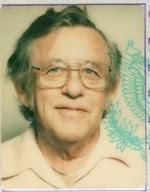 Last week Pete Smith provided this image of a mystery numismatist. Cal Wilson was the first with the correct answer: Carling Gresham, a
past editor of our print journal, The Asylum. Thanks! Pete found the photo with Carling's death notice- he passed away in 2008. -Editor
Last week Pete Smith provided this image of a mystery numismatist. Cal Wilson was the first with the correct answer: Carling Gresham, a
past editor of our print journal, The Asylum. Thanks! Pete found the photo with Carling's death notice- he passed away in 2008. -Editor
Carling Gresham, 81 of Palatka, Florida passed away January 26, 2008. Carling was born in Jacksonville, Florida. He retired from the U.S. Army after 27 years of service where he flew mustangs. Survivors are his daughters, Tanya R. Gresham of Carlsbad, Ca., Myfanwy A. Gresham-Thomas of Denver, Co., Garnet G. Gresham of Las Vegas, Nv.; grandchildren, Kalo Copenhaver, L. Nyan, Fawnell and Lauren Gresham; great grandchildren, Savana and Bo Copenhaver.
Pete adds:
Apparently his first name was Billie. I had not known that.
Dave Alexander writes:
I believe our mystery man in the recent E-Sylum is the late Carling Gresham, long ago of the Coin World staff and a notable controversialist as editor of FUN Topics, where he lambasted FUN officers with spectacular abandon. Some early issues of The Asylum featured a number of verbal assaults of somewhat less violence on early NBS members. The story of a disaffected girlfriend driving his expensive sports car far out on the sands of Daytona Beach and leaving it there to greet the incoming tide made headlines in its day,
Carling was also a competent researcher, see his booklet on the Green Cross Medal issued by Scots adventurer Gregor MacGregor on Amelia Island, Florida in 1817. A veteran in the early struggle for South American independence, MacGregor led a storybook career that is little known in the U.S.
Can anyone tells us more about Carling? -Editor
To read the complete obituary, see:
Billie Carling Gresham
(http://wattsfuneralhomes.com/billie-carling-gresham/)
To read the earlier E-Sylum article, see:
NOTES FROM E-SYLUM READERS: MAY 29, 2016 : Quick Quiz: A Mystery Numismatist
(www.coinbooks.org/esylum_v19n22a09.html)
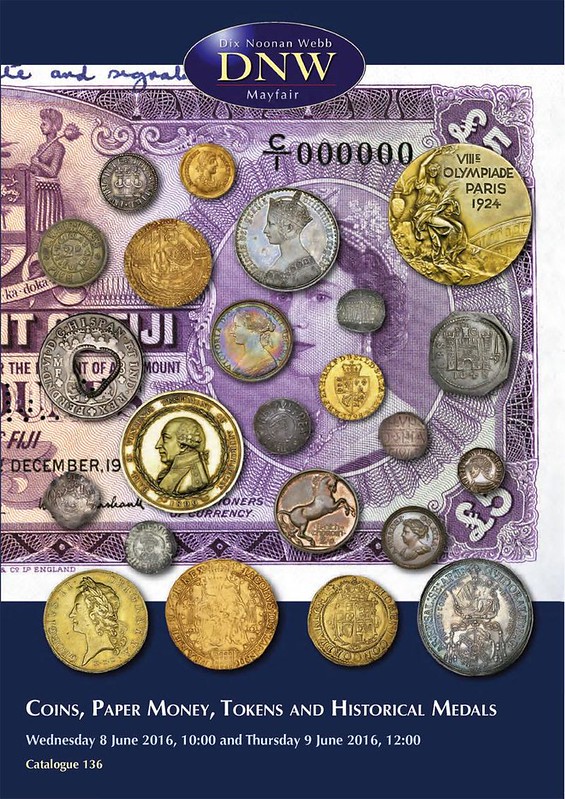
BILL PROPOSES SAINT-GAUDENS NATIONAL ARTS PARK
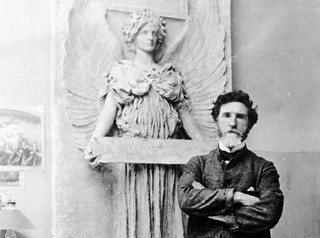 Two bills have been introduced proposing the redesignation of the Saint-Gaudens National Historic Site in Cornish, New Hampshire to the
“Saint-Gaudens National Park for the Arts.” The companion bills were submitted simultaneously on May 12 by Sen. Jeanne Shaheen (D-NH) and Rep. Frank
Guinta (R-NH1).
Two bills have been introduced proposing the redesignation of the Saint-Gaudens National Historic Site in Cornish, New Hampshire to the
“Saint-Gaudens National Park for the Arts.” The companion bills were submitted simultaneously on May 12 by Sen. Jeanne Shaheen (D-NH) and Rep. Frank
Guinta (R-NH1).
Augustus Saint-Gaudens was born in Ireland, raised in New York City, and went on to become one of America’s greatest sculptors. He created some of the nation’s best-known public statues, including Standing Lincoln (1887) in Lincoln Park in Chicago, the Sherman Memorial (1903) in Central Park, N.Y.C., and the Robert Gould Shaw Memorial (1897) on Boston Common. His sculptures are also housed in museums around the world, including the National Gallery of Art in Washington, D.C. and the Metropolitan Museum of Art in New York.
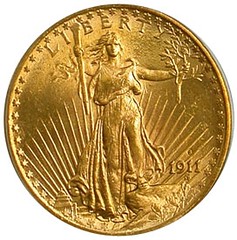 Saint-Gaudens is also known to numismatists as the designer and sculptor of two of America’s most iconic coins, the 1907-1933 Gold Eagle
and Double Eagle. President Theodore Roosevelt hand-picked him to design these issues as part of an initiative to elevate the quality of United
States coinage. Saint-Gaudens died shortly after submitting his designs, however, and never got to see the finished issues.
Saint-Gaudens is also known to numismatists as the designer and sculptor of two of America’s most iconic coins, the 1907-1933 Gold Eagle
and Double Eagle. President Theodore Roosevelt hand-picked him to design these issues as part of an initiative to elevate the quality of United
States coinage. Saint-Gaudens died shortly after submitting his designs, however, and never got to see the finished issues.
The identical bills (S. 2923 and H.R. 5206) are titled “The Saint-Gaudens National Park for the Arts Redesignation Act” and seek to re-conceive the site in accordance with its unique character and history. The area comprises 370 acres and houses the sculptor’s home, gardens, and studios. It was also the center of the Cornish Art Colony, one of the earliest and most vibrant communities of this type, which featured concentrations of painters, writers, architects, and musicians.
GovTrack.us currently puts the bills’ odds of passage at about 23%, which is fairly high for such a recent proposal, thanks in part to cooperation between members of Congress across party lines.
Notably, Saint-Gaudens employed a number of a young sculptors over the course of his career, including Adolph A. Weinman, who would go on to design the Mercury dime and Walking Liberty half dollar.
Saint-Gaudens’s home received Congressional authorization to become a National Historic Site on August 31, 1964, and officially assumed that status in May 30, 1977.
To read the complete article, see:
Proposed Legislation Aims
to Designate Saint-Gaudens Site as National Arts Park
(http://mintnewsblog.com/2016/06/legislation-aims-to-designate-saint-gaudens-site-as-national-arts-park/)
ROYAL CANADIAN MINT ARTIST GLEN SCRIMSHAW
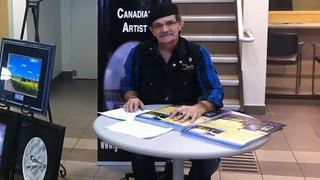 Glen Scrimshaw has always wanted to be a painter.
Glen Scrimshaw has always wanted to be a painter.
As a child growing up in Big River, Sask., he remembers drawing on the walls of his family's home while his father did renovations.
The self-taught artist never stopped drawing, even as he worked as a store manager all across northern Saskatchewan and Manitoba.
"During some of those postings, in one town, there were 80-some people, and there was no telephone. There was a radio phone in the store. There was no television," he said. "I had lots of time on my hands, so I continued to paint and sketch."
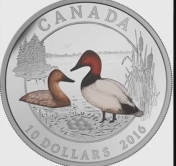 Now, 30 years later, Scrimshaw has become a household name across the province. Last year, his design of a canvasback duck made it onto a
$10 collectible coin made by the Royal Canadian Mint.
Now, 30 years later, Scrimshaw has become a household name across the province. Last year, his design of a canvasback duck made it onto a
$10 collectible coin made by the Royal Canadian Mint.
"That has been a pretty big highlight," he said. "My dad was a coin collector, and I spent many hours with him looking at coins, and I can just imagine what he would say if he was here."
Scrimshaw is best known for his detailed nature paintings, often incorporating the northern lights or lightning into his pictures.
"I love nature," he said. "Every time you look at nature, you can see something more... If you look on the shoreline of a lake, all of a sudden you might see a moose on the shore you didn't even know was there. I try to do that in my paintings as well."
Scrimshaw now owns a gallery in Saskatoon and a small framing shop in his home community of Duck Lake, Sask. He thinks he'll be painting for as long as he can.
"It's like breathing," he said. "If I can't paint something for a month, it's like something very important is missing out of my life."
To read the complete article, see:
Sask. artist Glen Scrimshaw celebrates 30 years of
making ar (www.cbc.ca/news/canada/saskatoon/glen-scrimshaw-30-years-art-1.3610823)
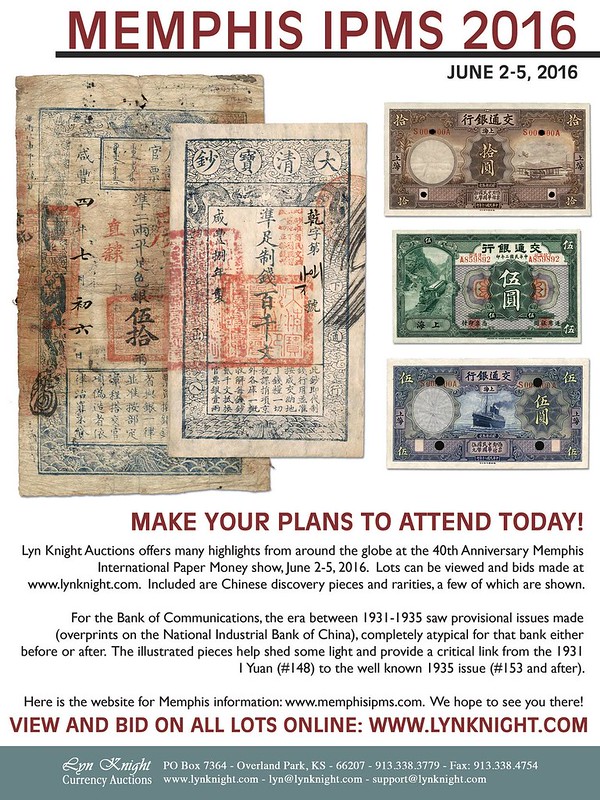
COINWEEK POGUE IV AUCTION ANALYSIS
As noted last week, the two highlights of the sale, the 1804 Dollar and 1822 Half Eagle failed to meet the reserve prices placed on them by the consignor. Be sure to read the complete article online - this is just an excerpt. -Editor
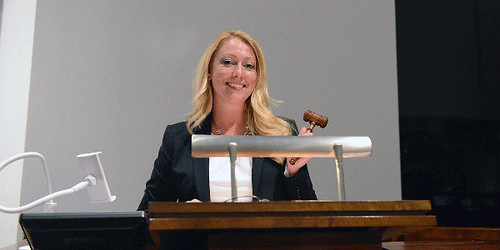
Melissa Karstedt calling Pogue IV sale
“Any interest at Seven Million Six Hundred Thousand? That is what you would have to bid.”
The dollar stood just a few feet away, housed in a rectangular glass case held upright by a clear plastic stand. Untouchable, and removed from the context of a great collection, its physicality seemed to diminish with every foot that separated it from the audience.
And those that had come to bid–and were cleared to bid on such a rare and expensive coin–were but a tiny fraction of that audience.
It is perhaps for this reason that the lot played out like it did and perhaps also why we must adjust our understanding of how Pogue IV unfolded to take into account a perspective that analysis of the sale so far has missed.
“Seven Million Six Hundred Thousand…”
From where we were sitting, one could see the subtle interplay of some of the industry’s biggest coin dealers as Melissa called out the starting price. Some sat stone-faced. Others sank ever so slightly into their seats. One dealer from California mercurially furrowed his brow as if in disbelief.
There was a range of reactions and emotion on the floor. It may have been too subtle for a laptop or smartphone, but what played out on the seventh floor of Sotheby’s auction house that night wasn’t quiet.
Especially considering the fact that the Pogues’ reserve price had beaten back all of the industry’s elite dealers and market makers, rendering them spectators in a seven minute tug-of-war between an ultra-wealthy owner and an ultra-wealthy bidder.
The Pogue IV catalog differentiated itself from the three catalogs that preceded it in one key way: price estimates were not printed at the bottom of each lot. Instead, a separate loose sheet was included, along with a mail-bid form and an envelope.
The 1804 and 1822 headliners were the reason for this change in format.
While building session IV around these two coins, Stack’s Bowers anticipated that the Pogue family would want to place reserves on what the family perceived to be the premier pieces of the entire collection.
So the company, working against a firm deadline and the need to communicate important information to potential bidders, gave the Pogue family time to carefully consider the pricing levels that they required to part with their most treasured coins.
In the interim the catalogs were dispersed and the pre-auction process got underway. Those interested in any of the non-reserved lots were provided a range of estimates as to what the final price would be. Those interested in the 1804 and the 1822 were invited to inquire for more details.
Ultimately, final reserve prices were not in place until 5pm the night of the auction, which means that most people on the floor were probably unaware of them.
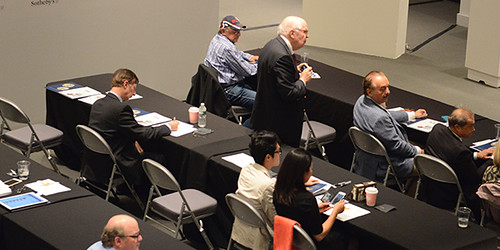
Q. David Bowers rises to photograph the historic moment the 1804 dollar was up for bid.
In the week since the Pogue IV sale took place we’ve watched and rewatched the footage of those seven minutes, taking in each frame as if it were the Zapruder film.
We’ve spent years digging around auction records and looking at realized prices for coins, but for the great rarities there is no rhyme or reason to justify what people are willing to pay on any given day.
The bottom line is this: nobody knows what the values of coins like these are. Only a handful of people can afford them in the first place. They are either unique or semi-unique. They have tremendous cultural and historical importance.
In the colloquial sense of the word, they are priceless.
Ultimately, the Pogues didn’t need to sell the coin.
If you want to own the treasures of the Mack and D. Brent Pogue Collection, don’t expect a bargain and don’t expect it to be easy.
To read the complete article, see:
Pogue IV Auction Analysis: Why Did
You Expect It To Be Easy? (www.coinweek.com/auctions-news/auction-analysis/pogue-iv-auction-analysis-expect-easy/)
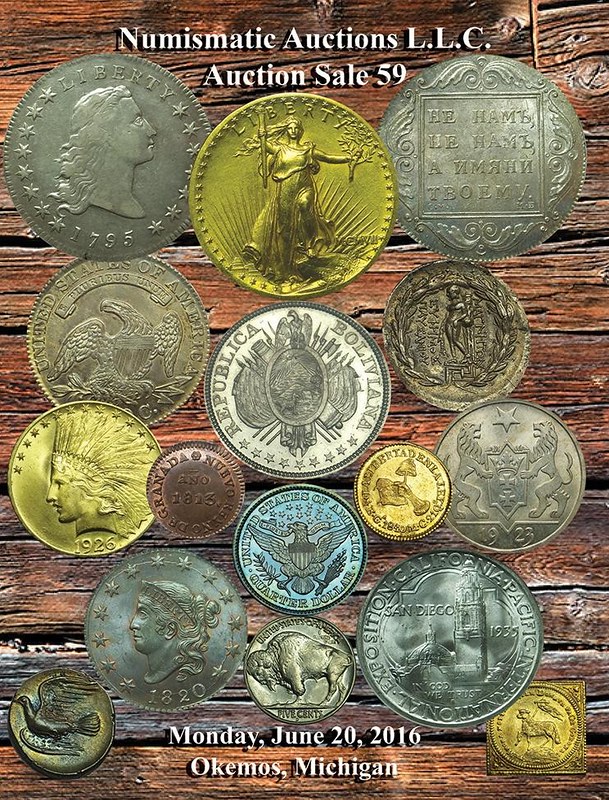
SILVER ROUNDS FEATURE HOBO NICKEL DESIGNS
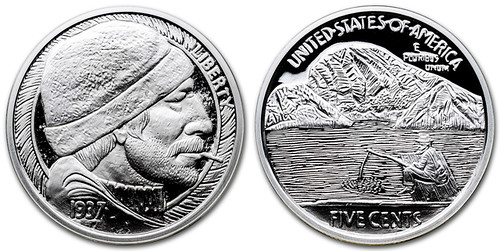
Some collectors are pioneers. They head off in directions where the mainstream does not follow.
Where most of us buy the book, buy the album and then fill it up, others don’t want to be bound by convention.
Good for them.
Being a pioneer means not knowing how it will all turn out. They do what they like. Personal satisfaction means more than a well traveled collecting road.
A recent pioneering effort that caught my eye has to do with hobo nickels.
The originals were done more than three generations ago when Buffalo nickels were in circulation and clever artists redid the design by hand.
Collectors spotted these and began to collect them.
The Original Hobo Nickel Society was founded in 1992 and a new generation of artists took up the craft. Amazing works have been created.
The next step is apparently silver rounds that are reproductions of the works of the new hobo nickel artists.
Osborne Mint is creating a series of five pieces in 2016 that shows the work of Paolo Curcio, who is known as “Mr. The.”
Collectors can buy these pieces as they buy their bullion from firms like APMEX, Provident, JM Bullion, Littleton Coin Company and SilverTowne.
“The Fisherman” design was the first one issued in 2016. The second was “The Train” and the third one was released yesterday called “Skulls and Scrolls.”
On July 26 “Green Fair Fishbone” is due and on Sept. 27 “Jefferson Skull Scroll” will arrive.
There is a one-ounce proof, a one-ounce antique finish and a five-ounce antique finish.
There is a maximum of 10,000 of each available. A serial number appears on the edge.
Today’s price for a one-ounce .999 fine piece is $27.05. This will change as silver fluctuates.
Pioneers will be buyers. What happens next not even they know, but because they like them, they will enjoy the ride.
To read the complete article, see:
Are you a pioneer? (www.numismaticnews.net/buzz/are-you-a-pioneer)
TRADE DOLLARS IN OREGON 1875-1876
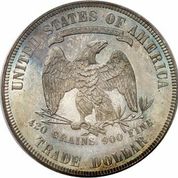 As a snapshot in time, it is interesting to come across a firsthand account of trade dollars in circulation domestically. Astoria, as well
as most of the Oregon country at that time was quite isolated, having no rail connections with California or with the East. While essential
self-sufficient for food, it was dependent upon San Francisco, 700 miles to the south, to supply its manufactured and luxury goods needs via
steamship and sailing vessels.
As a snapshot in time, it is interesting to come across a firsthand account of trade dollars in circulation domestically. Astoria, as well
as most of the Oregon country at that time was quite isolated, having no rail connections with California or with the East. While essential
self-sufficient for food, it was dependent upon San Francisco, 700 miles to the south, to supply its manufactured and luxury goods needs via
steamship and sailing vessels.
Here in late May 1876, the Treasurer indicates “... that people generally paid their taxes this year in silver”.....and that, “...3⁄4 of all the taxes paid into the Treasury of Clatsop county, was silver and a very material proportion of that was Trade Dollars.”
Of note, the Treasurer has qualified his statement by using the wording that most individuals paid their taxes in silver “this year.” Thus making a distinction that taxes in previous years were paid differently, and that meant gold coin. Legal Tender paper currency likely was not accepted by the County Government, any one holding such notes had to go to a brokerage house of bank and exchange the paper notes for gold or silver coin at a steep discount. The financial page in the same paper indicates you could get 88 cents per paper dollar.
Trade dollars were expected to have been exported and used in trade with the Orient, but the law creating them had also included the provision that they were legal tender domestically in amounts up to $5.
This matched the same legal tender limits that applied to the silver subsidiary coin (i.e. half, quarter, 20c, dime, and half-dime). Gold coin was legal tender in any amounts, but people could refuse to accept silver coin in amounts greater than $5.
There was however a distinct difference between trade dollars and subsidiary silver coin. Subsidiary silver coin was only supposed to be obtainable from the Government by exchanging gold coin for them, whereas, anyone holding silver bullion could take that bullion to the Mint and have it converted into trade dollars, 378 grains of pure silver to a coin, and pay a nominal “minting charge,” which was required to be the actual cost the Mint expended to coin the bullion received, and walk away with a dollar coin that was legal tender up to $5.
What had happened since the trade dollars were created in 1873, silver bullion prices (priced in gold coin) had declined so much, that the cost of 378 grains of silver along with the nominal minting charge to coin a single trade dollar coin, was actually less than the dollar face value that the coin would bring in domestic circulation. Thus, people that had access to silver bullion and were in the know, started taking their bullion to the Mint and having it converted into trade dollars, spending them domestically. Thus making a profit on each coin spent. Carothers in his book Fractional Currency, indicates that the tipping point occurred with the price of silver in early 1876, and by the middle of 1876, trade dollar coins were flooding retail trade in California.
For more information on the Liberty Seated Collectors Club, see:
www.lsccweb.org

Archives International Auctions, Part XXXIII
Chinese, Asian &Worldwide Banknotes,
and Chinese Scripophily
June 28, 2016
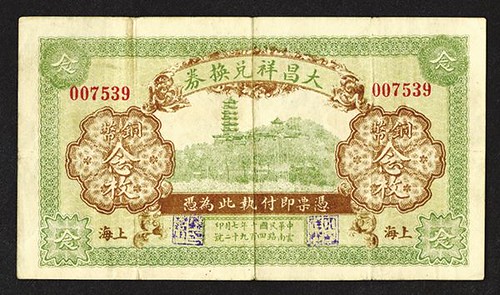
Click the links! Highlights include:
Lot 198: American-Oriental Banking Corporation, 1919 “Shanghai Branch”
Lot 245: Dah Chon Chang Money Exchange, ca.1920's "Shanghai"
Lot 315: Republik Indonesia Unlisted 1948 Issue Essay Specimen
Lot 451: Banco de Portugal - Azores. 1909 Issue
Lot 475: Imperial Do Brazil (1882) Issue Color Trial Essay Proof
Lot 700: Comite Bancario de Guatemala. 1899 Issue
Lot 889: Bank of Rhodesia & Nyasaland. 1960 Issue.
Lot 1006: Central Bank of Turkey. 1930 Law Issue
View the Virtual Catalog
Download the Catalog in PDF format
ARCHIVES INTERNATIONAL AUCTIONS, LLC
1580 Lemoine Avenue, Suite #7
Fort Lee, NJ 07024
Phone: 201-944-4800
Email: info@archivesinternational.com
WWW.ARCHIVESINTERNATIONAL.COM
CIVIL WAR TOKEN SCRIP MATES
A few items in the Summer 2016 installment caught my eye. It covers merchants in New York state. Many thanks to Susan and David for these images. The token images were not in the article, but are instead taken from the club's update of the Fuld Civil War Token Store Cards book. -Editor
Eastman National Business College, Poughkeepsie, NY
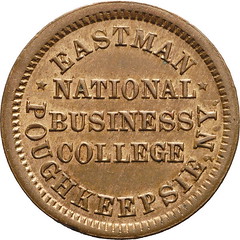
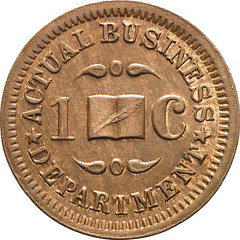
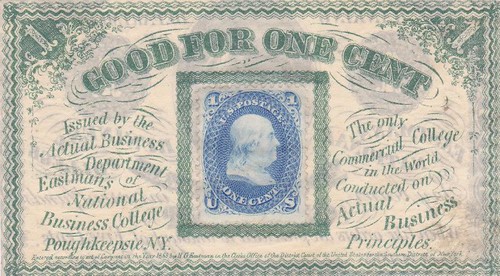
David Gladfelter writes:
The Schingoethe catalog lists two varieties of the 1 cent note, one with a blank frame and one with a female allegory in the frame. It isn't listed with a stamp in the frame.
A. M. Johnson, Buffalo, NY
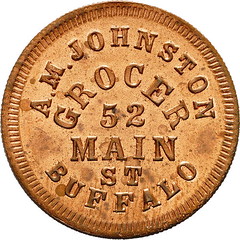
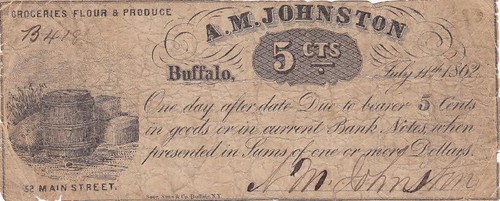
Robinson &Ballou, Troy, NY
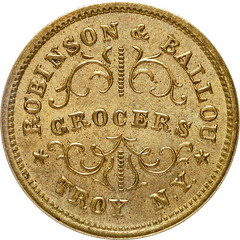
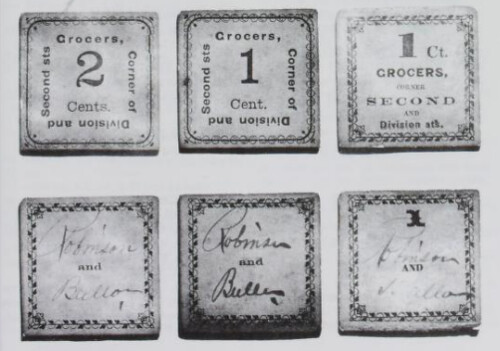
D. L. Wing, Albany, NY
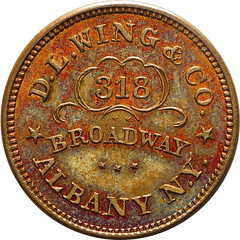
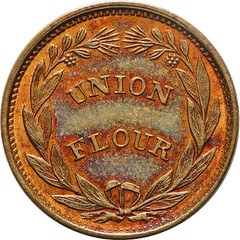
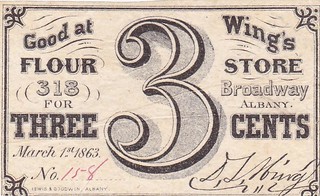
White the Hatter, New York City
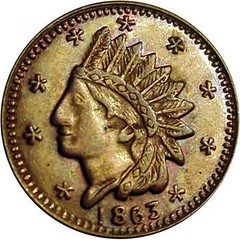
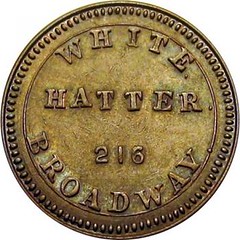
White the Hatter Civil War token
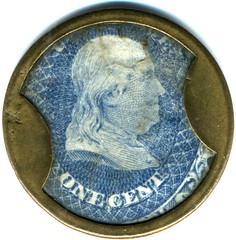
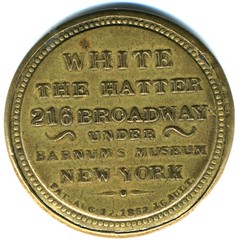
White the Hatter encased Postage stamp
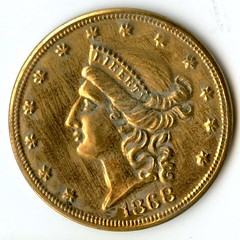
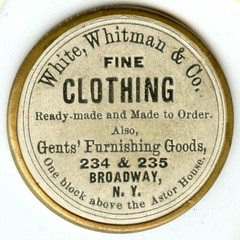
White, Whitman &Co. Shell card
"Scrip mates" are a challenge for the true numismatist - you have to be a generalist with interest in multiple fields to make these connections and bring the material together, be it for a collection, an exhibit or article. Looking at the tokens alone does not give the full picture of the issuer's activities and business - the group is worth more than the sum of its parts to a researcher. -Editor
For information about the Civil War Token Society, send email to the Secretary, John Ostendorf, at johnoste@yahoo.com or write to him at 523 Hiwasee Rd., Waxahachie, TX. 75165. He will send you a brochure and on request, a sample journal issue.

HALL OF FAME FOR GREAT AMERICANS MEDALS
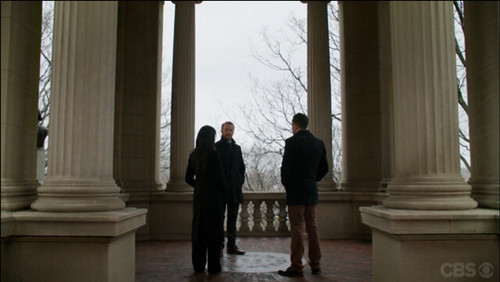
From the Bronx Community College’s webpage for the Hall of Fame:
The principal feature of the Hall of Fame is its 630-foot open-air Colonnade, which houses the bronze portrait busts of the honorees. Designed by the celebrated architect Stanford White and financed by a gift from Mrs. Finley J. Shepard (Helen Gould) to New York University, the Hall of Fame was formally dedicated on May 30, 1901.
The Colonnade was designed with niches to accommodate 102 sculptured works and currently houses the busts and commemorative plaques of 98 of the 102 honorees elected since 1900.
The 98 bronze busts that line the Colonnade are original works by distinguished American sculptors. The bronze tablets recessed in the wall beneath the busts carry inscriptions of significant statements made by the men and women honored. Among the master sculptors represented here are Daniel Chester French, sculptor of the Lincoln Memorial; James Earl Fraser, whose work includes the figures of “Justice” and “Law” for the U.S. Supreme Court, and Frederick MacMonnies, whose reliefs grace Fifth Avenue’s Washington Arch.
Actor Edwin Booth
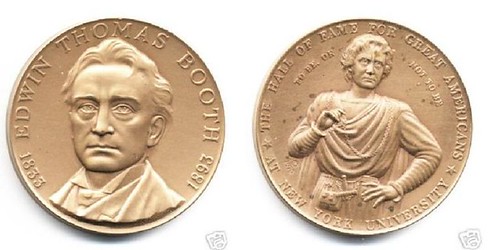
William Cullen Bryant
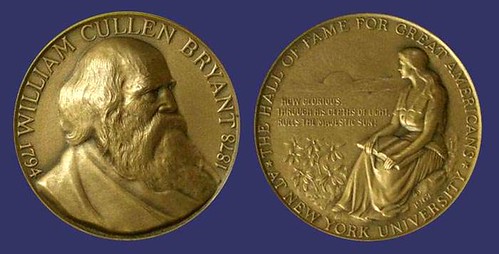
Oliver Wendell Holmes
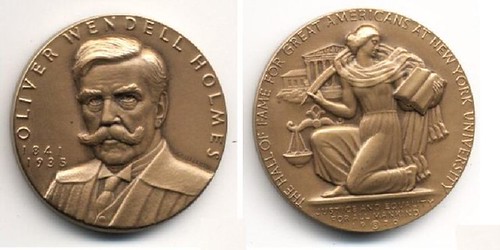
Samuel Langhorne Clemens (Mark Twain)
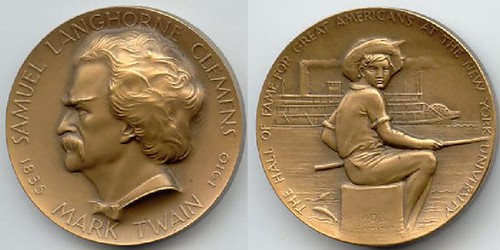
To read the complete article, see:
Elementary’s
Holmes and Watson at the Hall of Fame for Great Americans
(http://fourthgarrideb.com/2016/06/elementarys-holmes-and-watson-at-the-hall-of-fame-for-great-americans/)
For more information on the series, see this 2012 article from Dick Johnson's MedalBlog:
Hall of Fame Series — The Most
Successful Medal Program (https://medalblog.wordpress.com/2012/12/03/hall-of-fame-series-the-most-successful-medal-program/)
THE PHOTOPLAY MAGAZINE MEDAL OF HONOR
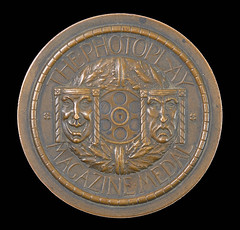
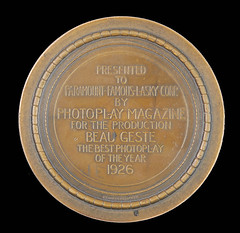
Photoplay’s 1926 Best Picture Award for Beau Geste
Extremely rare bronze Photoplay Magazine Medal of Honor, just under 3″ in diameter, engraved on the reverse: “Presented to Paramount-Famous-Lasky Corp. by Photoplay Magazine for the Production Beau Geste, the Best Photoplay of the Year 1926.” The front of the medal features the traditional symbolic dramatic masks raised in high relief. In very good condition, with overall tarnishing, a few light dings and scratches, and the initials “JE” etched to the left of the presentation engraving.
Beginning in 1920, Photoplay gave out what is considered the first significant annual movie award, the Photoplay Medal of Honor. The award was voted on by readers of the magazine and the producer of the winning film was presented with a gold medallion struck by Tiffany, which was generally kept by the studio; bronze copies such as this were created in very limited amounts as individual keepsakes for some of the film’s important participants. Though Photoplay only gave the single award for best film, its intentions and standards were influential on the Academy Awards founded later in the decade.
To read the lot description, see:
#8176 - Beau Geste Photoplay 1926 Best Picture Bronze
(www.rrauction.com/preview_itemdetail.cfm?IN=8176)
 Several years before the first Academy Awards ceremony took place in 1929, Photoplay magazine, one of the earliest and most successful
movie fan publications, began awarding what are considered to be the first major prizes for moving pictures, the Photoplay Medal of Honor, and these
were decided on by the devoted, paying public.
Several years before the first Academy Awards ceremony took place in 1929, Photoplay magazine, one of the earliest and most successful
movie fan publications, began awarding what are considered to be the first major prizes for moving pictures, the Photoplay Medal of Honor, and these
were decided on by the devoted, paying public.
From the contest’s inception in May 1921, the Photoplay Medal of Honor oozed lofty ambition: “PHOTOPLAY MAGAZINE has determined to permanently establish an award of merit,” said one of the magazine’s earliest full-page announcements, “a figurative winning post comparable to the dignified and greatly coveted prizes of war and art.” The Medal of Honor would be crafted of solid gold by the illustrious Tiffany and Co., and presented only to the producer (not, to be clear, the director or the distributor) “whose vision, faith, and organization made the Best Photoplay a possibility.” At the bottom of the page, loyal readers were provided with a handy short list of suggested Best Pictures of 1920—which included such frothy titles as Suds and Remodeling a Husband—and a ballot with which to cast their vote. And thus was born the precursor to the Academy Awards, a distinction that, “like Abraham Lincoln’s ideal government,” was “by, of, and for the people.”
Such florid language was par for the course in the magazine, which was first published in 1911 and in its earliest days focused on story adaptations of popular movies. Starting in 1915, James R. Quirk became the editor and oversaw the magazine in its most influential period through 1932. The magazine featured full-page portraits of glamorous movie stars, such as Greta Garbo, Douglas Fairbanks, and John Gilbert, interspersed with industry gossip; brief, to-the-point moving picture reviews; puffy interviews; and the occasional reader contest.
To read the complete article, see:
The
Oscars Before the Oscars (www.slate.com/articles/arts/the_oscars/2016/02/
a_history_of_the_photoplay_magazine_medal_of_honor
_the_populist_movie_award.html)
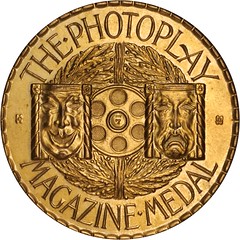
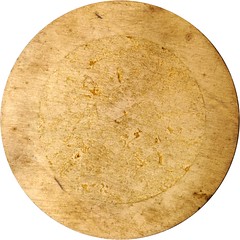
To read the complete lot description, see:
Undated (Circa 1960) Photoplay
Magazine Medal. Gilt Bronze. 63 mm. (http://old.stacksbowers.com/BrowseAuctions/LotDetail.aspx?AuctionID=6008&Lot=51&LotID=338932)
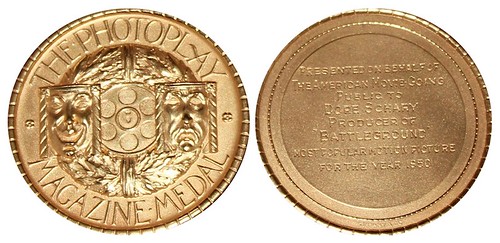
This Tiffany &Company produced 14kt Yellow Gold Medal Token Award was given and presented to the Producer, Dore Schary, by “The American Movie Going Public” of Photoplay Magazine for Best Picture for the movie: “Battleground” in 1950.
Size: 2.5 Inches in Diameter.
Weight: 3.01 ounces Pure Gold.
Price: $11,000.00
To read the complete item description, see:
PHOTOPLAY MEDAL OF HONOR: DORE SCHARY
(www.paulalbarianjewelry.com/product/photoplay-medal-of-honor-dore-schary/)

1804 WILLIAM LANGMUIR COUNTERMARK SOUGHT
Eric Hodge (writing to PAN):
Clarion magazine Vol. 23 number 1, Mar/Apr 2006 pages 8-9 Unique Discovery.
Dear Sir/Madam. I live in the UK and am an amateur numismatist specialising in UK merchant countermarked silver coins from the period 1780 to 1830. Since the death last year of Harry Manville I have tried to continue his work in this area.
I have just seen the above magazine and the article refers to a countermarked 8 reales for W Langmuir of Paisley in Scotland. The article was written by Dr. Henry Stouffer and he states he has an 1804 8 reales with this countermark. If possible I would like to obtain photographs of this coin.
Do you know Dr. Stouffer? Is it possible to trace him or his coin collection? Thank you for any advice or help you can give me.
Yours Faithfully. Eric Hodge.
Pat McBride writes:
Dr. Stouffer no longer owns the 1804 piece and can’t recall where it is now. E-Sylum readers my be able to track down more information and help Eric.
Unique Discovery
by Dr. Henry Stouffer
I'm sure that many of you have been delighted to have come across a coin, medal or token that has spurred a great deal of research and investigation. In my 57 years in the hobby, I've been quite fortunate, having found the fifth known “ugly head” Washington medal, as well as several rare large cents.
However, the subject of this story, concerning an eight reale piece dated 1804, had an amazing conclusion. The subject coin came into my hands about a year and a half ago.
The first thing I noticed was heavy counterstamping — not only on the obverse, but also on the reverse. Our friend Charles (Carolus) the 4th was pretty much obliterated on the obverse, with the legend, “Payable by W. Langmuir” and some kind of interior design. But most interesting was a heavy grill-like counterstamp on the reverse, with the legend “Paisley Dollar Society,” with the numeral “50” centered on it. This covered about 60 percent of the reverse.
The Search
Well, what to do next? I knew Q. David Bowers had a great interest in counterstamps, and Jerry Kochel and I had taken part in the first ANA
Seminars at Penn State some 20 years ago -- in which David Bowers participated, I took his course on the history of U. S. coins.
Q. David Bowers
So I wrote Dave, giving him all the information about the coin, and enclosed a pencil rubbing of it. In less than a week, I received a
reply from Dave in which he told me he had taken the liberty of sending on all my information to Russ Rulau.
Russ Rulau
About two weeks later, a letter arrived from Russ Rulau in which he informed me that the piece was a quite-well-known Scottish token issued
on or after 1814 by William Langmuir, a miller and grain dealer of Paisley, Rengrewshire, in an attempt to pass the Spanish Dollar for 5
Shillings 3 Pence. (What I had thought to be a “50” turned out to be “5/3.”), when 4 Shillings 9 Pence was more acceptable in Scotland.
Gregory Brunk
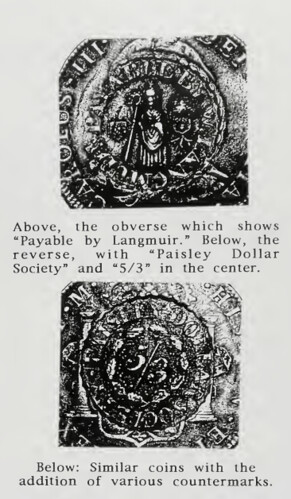 He also noted that a gentleman named Gregory Brunk had done a work (in 2003) in which he reported 16 known specimens in collections in
various dates from 1774 to 1814. Then, through Rich Hartog, I wrote Gregory Brunk in Hudson, Iowa. In his reply, he acknowledged that I had an
unlisted example of the Langmuir/Paisley Dollar Society countermark. He went on to say that merchants issued countermarked pieces at guaranteed
specific values — e.g. 7 Shillings and 6 Pence. So, if the price of silver went below that value, people turned them in. Then, to prevent them from
being redeemed twice, the merchant would “cancel” the redeemed coin with a chisel or hammer.
He also noted that a gentleman named Gregory Brunk had done a work (in 2003) in which he reported 16 known specimens in collections in
various dates from 1774 to 1814. Then, through Rich Hartog, I wrote Gregory Brunk in Hudson, Iowa. In his reply, he acknowledged that I had an
unlisted example of the Langmuir/Paisley Dollar Society countermark. He went on to say that merchants issued countermarked pieces at guaranteed
specific values — e.g. 7 Shillings and 6 Pence. So, if the price of silver went below that value, people turned them in. Then, to prevent them from
being redeemed twice, the merchant would “cancel” the redeemed coin with a chisel or hammer.
Harrington Manville
Brunk also wrote that the world expert on these is a man named Harrington Manville, who published “Tokens of the Industrial Revolution”
(Spink - 2001), which is subtitled, “Foreign Silver Coins Countermarked for use in Great Britain c. 1787 - 1828.” Brunk said further that
he had forwarded my letter to Manville.
At the right are photos of coins of this type — the upper ones showing the Langmuir/Paisley Dollar as it was issued, and below, showing it with countermarks.
Now, to the amazing conclusion. I was given a listing of the known dated specimens, and recognizing that the U.S. 1804 Dollar is numismatically famous, it turns out that our specimen is the first known — and only one with the date of 1804. How about that !
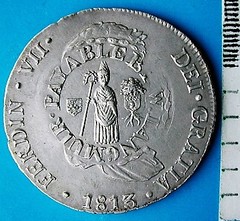
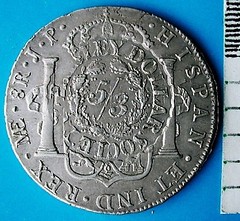
To read the complete Clarion issue, see:
The Clarion, vol. 23, no. 1 (https://nnp.wustl.edu/library/book/512822)

2016 DAMIN CONFERENCE VISITS SAN FRANCISCO
From the pre-conference announcement:
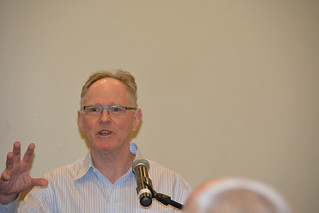 The goal of the 2016 meeting is to continue traditional monetary history under DAMIN, while at the same time encouraging dialogue among
monetary historians, numismatists, mining historians, geologists, and other scientists (see, for example, interdisciplinary linkages encouraged by
the International Big History Association).
The goal of the 2016 meeting is to continue traditional monetary history under DAMIN, while at the same time encouraging dialogue among
monetary historians, numismatists, mining historians, geologists, and other scientists (see, for example, interdisciplinary linkages encouraged by
the International Big History Association).
The object is to encourage broad historical analysis of diverse trade objects in relation to means of exchange, including geological concentrations of raw materials across the globe, exploration, mining (in the case of metals), monetary production (including minting), and distribution of final products to end-markets throughout the world. Envisioning monetary history broadly is important because control of raw materials conferred economic power, as did fabrication of monies, exchange of monies for other monies, and exchange of monies for non-monetary items.
Equivalent linkages existed for non-metallic payment devices documented throughout history. In some cases, uneven distribution of mines across the globe induced authorities to adopt alternative means of payment, such as chocolate, cowries, rice, beans, textiles, and numerous other monetized objects. These choices influenced social, political, and trade relations, leading to diverse monetary arrangements and various paths of economic development around the world.
From the post-conference Proceedings:
Given emphasis upon nineteenth-century topics at this 2016 California conference, organizers decided to meet initially for two days in San Francisco, a city founded in response to California’s post-1848 Gold Rush, yet propulsion of metropolitan San Francisco to global status depended upon post-1859 Comstock Lode silver discoveries in Nevada (as emphasized in conference presentations).
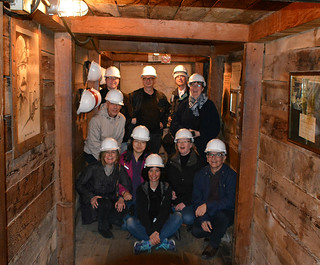 The conference venue shifted on Day 3 eighty miles eastward to the School of International Studies, University of the Pacific, in Stockton,
a deep-water port founded at the time of the California Gold Rush. A lecture at Lake Tahoe on Day 4 focused on provision of water from the
Nevada-side of the Sierra Nevada Mountains – gravity fed eastward down into the Carson Valley – then pushed up to the Comstock Lode farther eastward
during the 19 th century. The venue for Day 5 was historic Virginia City, Nevada, which is sinking due to its location directly atop a vast maze of
mines shafts of the Comstock Lode, world dominant source of silver for decades. (There was also a side-visit to Sutro Tunnel, designed to drain
wastewater from deep within Comstock Mines westward down into the Carson Valley.)
The conference venue shifted on Day 3 eighty miles eastward to the School of International Studies, University of the Pacific, in Stockton,
a deep-water port founded at the time of the California Gold Rush. A lecture at Lake Tahoe on Day 4 focused on provision of water from the
Nevada-side of the Sierra Nevada Mountains – gravity fed eastward down into the Carson Valley – then pushed up to the Comstock Lode farther eastward
during the 19 th century. The venue for Day 5 was historic Virginia City, Nevada, which is sinking due to its location directly atop a vast maze of
mines shafts of the Comstock Lode, world dominant source of silver for decades. (There was also a side-visit to Sutro Tunnel, designed to drain
wastewater from deep within Comstock Mines westward down into the Carson Valley.)
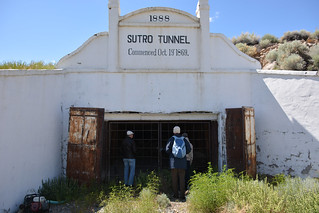 An afternoon in Old Town Sacramento, historic port-city and railroad town through which Nevada silver was exported, highlighted the return
trip to San Francisco on Day 6. It is hoped that in-person views of California/Nevada geological formations, challenging transportation routes,
mines, coins, and environmental legacies have helped participants to visualize integrated systems that have historically linked – and continue to
link – underground activities to diverse end-market destinations over thousands of years.
An afternoon in Old Town Sacramento, historic port-city and railroad town through which Nevada silver was exported, highlighted the return
trip to San Francisco on Day 6. It is hoped that in-person views of California/Nevada geological formations, challenging transportation routes,
mines, coins, and environmental legacies have helped participants to visualize integrated systems that have historically linked – and continue to
link – underground activities to diverse end-market destinations over thousands of years.
For more information on DAMIN, see:
www.anr-damin.net
KENT POLICE SEIZE MEDIEVAL COINS IN RAID
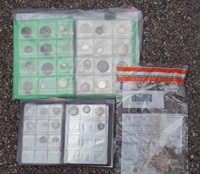 Historical artefacts have been seized from a house in Sittingbourne as part of a Kent Police investigation into illegal
metal-detecting.
Historical artefacts have been seized from a house in Sittingbourne as part of a Kent Police investigation into illegal
metal-detecting.
Medieval coins dating back to the 13th century were among the items found at the property in Chalkwell Road, Sittingbourne, on Wednesday 25 May 2016.
The warrant was the first in Kent to be carried out under Operation Chronos – a national campaign in conjunction with Historic England to tackle the practice of ‘nighthawking’. Enquiries are ongoing and no arrests have been made at this stage.
Inspector Dave Smith of Kent Police’s Rural Task Force said: ‘Nighthawking is where people go onto farmland, archaeological sites and other areas of interest to find and steal coins and other treasure for their historical and financial value.
‘This practice permanently deprives the country of our heritage and is one we are keen to tackle shoulder-to-shoulder with Historic England, whose policing and crime advisor Mark Harrison we have close ties with.
‘Kent Police has joined other forces nationally to have commenced a heritage crime investigation under Operation Chronos, which I hope demonstrates how serious we take the issue.’
The Sittingbourne warrant was one of a number of activities carried out by Kent Police and partner agencies across the county on Wednesday 25 May 2016.
To read the complete article, see:
Medieval coins seized from Sittingbourne address
(www.kent.police.uk/news/latest_news/160602_north_chronos.html)
THE BOOK BAZARRE
THE AFGHANISTAN CAMPAIGN MEDAL
The article was originally published in the Spring 2016 issue of The Watsonian, Volume 4, Number 1. The Watsonian is the official publication of the John H Watson Society. -Editor
“The campaign brought honours and promotion to many, but for me it had nothing but misfortune and disaster.”
With that comment, within the first two hundred words of STUD, we are given a strong viewpoint of Dr Watson’s regarding his participation in the Second Anglo-Afghanistan War of 1878 – 1880. That said, Dr Watson was honoured, as were all surviving troops that took part in the skirmishes of that conflict, for service to Queen and country.
Dr Watson wrote that, in 1878 after getting his Doctor of Medicine from the University of London, he underwent training, at Netley, for surgeons in the army and became attached to the Fifth Northumberland Fusiliers as an Assistant Surgeon. Before he could meet up with them in India, the Second Afghan War had broken out. Assuming that Dr Watson would join his fellow troops in early 1879, there is no mention of his participation in any military actions until he “served at the fatal battle of Maiwand.”
Elliott Kimball, author of Dr John H Watson At Netley, theorizes that Watson began his studies at Netley in October 1879 and finished them in March of 1880. According to Kimball, Watson was travelling on the Continent for personal reasons from June 1878 until October 1879. Utilizing these dates could justify that Watson’s first military action was at Maiwand on July 27, 1880.
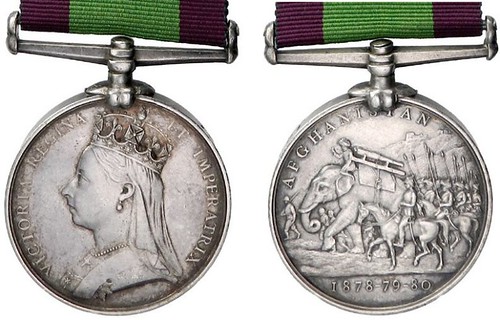
Watson’s service in Afghanistan makes him eligible to receive the Afghanistan Medal, a 36mm round, silver medal (some examples are known in bronze), with a 33mm wide dark green ribbon with crimson on both edges. The medal hangs from a plain suspender that has a double toe claw to hold the medal.
A left-facing bust of Queen Victoria is on the obverse (or front) of the medal. The legend of VICTORIA REGINA ET IMPERATRIX is around the border of the design. This profile of Victoria was designed by Joseph Boehm.
The central design of the reverse (or back) of the medal features an elephant carrying a cannon, with soldiers, marching and on horseback Below this is the dates 1878-79-80. In the upper left, above the design, is the word AFGHANISTAN. This design was done by Randolph Caldecott, an illustrator of children’s books.
The medal was engraved by Leonard Wyon of the British Royal Mint.
To read the complete article, see:
Dr. Watson’s Afghanistan Campaign Medal
(http://fourthgarrideb.com/2016/05/dr-watsons-afghanistan-campaign-medal/)
THE YUNNAN RATION GOLD COIN
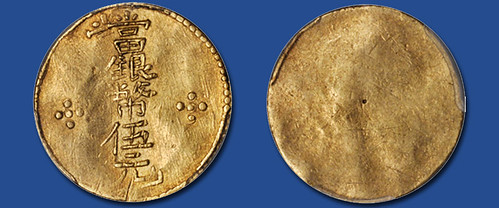
For this week’s preview of our upcoming Stack’s Bowers and Ponterio August Hong Kong Showcase Auction we have a rare and historically significant gold coin from the Yunnan region of China. Shortly after Yuan Shih-kai proclaimed himself emperor of China in December 1915, military Governor of Yunnan Tang Jiyu announced the independence of Yunnan. During the National Protection War, Tang was an important leader of the army and after the death of Yuan Shih-kai in June of 1916 Tang emerged as a dominant military leader in southern China.
Due to the rapid escalation of silver prices between 1916 and 1919 Yunnan exported large quantities of tin and had to take gold in exchange. Since the cost of the campaign against Yuan Shih-kai was enormous and the existing currencies were insufficient, Tang issued two different gold coins equal to $5 and $10 of silver to pay his soldiers. Since the price of gold was comparatively higher than that of silver the weight of these pieces was slightly reduced. It is said that Tang gave up his private gold holdings in order to mint these new coins, presumably from his profits from smuggling opium into China.
The significance of this coin lies in its rank amongst the rarest of circulating Chinese gold coinage. This coin features a relatively simple uniface design consisting of a vertical central legend stating: “Equivalent of Silver Dollars Five” flanked by five-pellet rosettes. This significant gold coin is sure to attract incredible attention from devotees of Chinese numismatics.
To read the complete article, see:
Historically Significant Yunnan Ration Gold Coin
(www.stacksbowers.com/News/Pages/Blogs.aspx?ArticleID=2111)
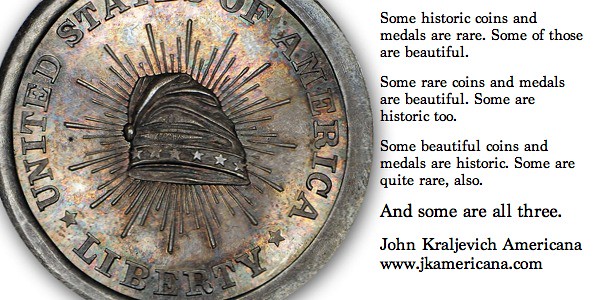
ROYAL MINT STRIKES GOLD KICK-OFF COIN
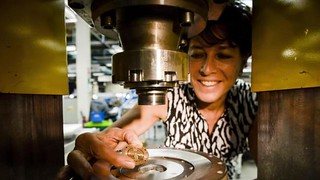 A gold coin struck by Bobby Moore's widow will decide whether England get the kick-off in their last game before Euro 2016.
A gold coin struck by Bobby Moore's widow will decide whether England get the kick-off in their last game before Euro 2016.
The Royal Mint has made a special £5 coin marking 50 years since England's 1966 World Cup win.
As well as bearing the Three Lions emblem, it also features the Jules Rimet Trophy - which was famously held aloft by Moore after the 4-2 Wembley win over West Germany.
A donation from each coin purchased will be made to the Bobby Moore Fund, which supports Cancer Research's pioneering research into bowel cancer.
The late West Ham favourite's widow Stephanie visited the Royal Mint in south Wales this week to strike one of the coins, which will take centre stage in the official coin toss in the friendly match between England and Portugal on Thursday evening.
She said: "I am delighted to have been invited to The Royal Mint to strike the official FA £5 coin to celebrate the 50th anniversary of England winning the World Cup.
The Football Association's chief executive Martin Glenn said the coin was a brilliant way of marking the half century since England won the World Cup on home turf in front of 96,000 fans.
He said: "It's fantastic not only just because it honours Bobby Moore, but also because it features Her Majesty the Queen, now in her 90th year, who is Patron of The FA - and who presented Bobby Moore with the Jules Rimet World Cup trophy on that famous afternoon in July 1966."
The limited edition coin, which will not go into general circulation, is available in either 22 carat gold or 925 sterling silver.
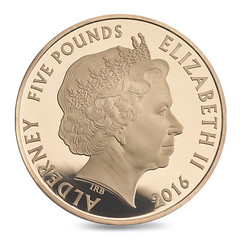
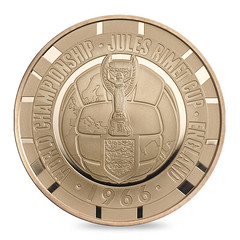
To read the complete article, see:
Three
Lions on the money as Bobby Moore's widow rekindles spirit of 1966
(http://home.bt.com/news/uk-news/three-lions-on-the-money-as-bobby-moores-widow-rekindles-spirit-of-1966-11364065717867)
For more information, or to order, see:
1966 FIFA World Cup £5 Gold Proof Coin
(www.royalmint.com/shop/1966_FIFA_World_Cup_5_Pound_Gold_Proof_Coin)
To read an earlier E-Sylum article, see:
HIGHLAND MINT STRIKES SUPER BOWL 50 COINS
(www.coinbooks.org/esylum_v19n05a37.html)

MORE CHOPMARKS ON MODERN U.S. PAPER MONEY
A web site visitor writes:
My name is Valerie and I am from Puerto Rico I find very interesting all that is related to chopmarks. I have been taking picture of many that I find while at work.
Valerie provided several images of chopmarks. Thanks! This is an interesting contemporary numismatic topic, and no reference work that we're aware of has yet been created. -Editor
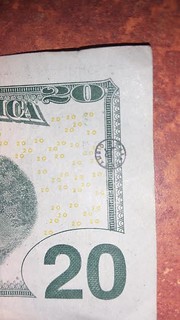
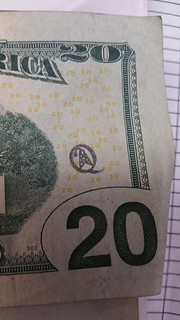
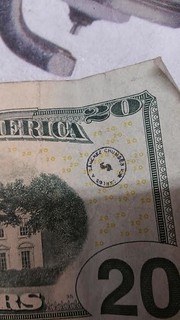
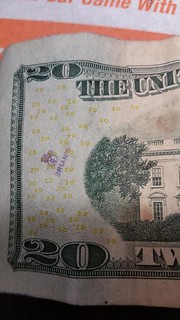
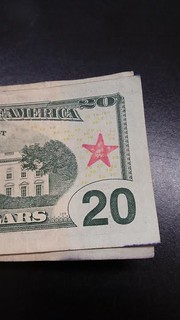
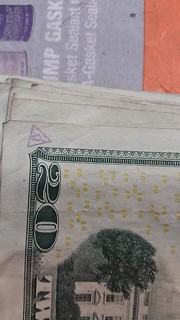
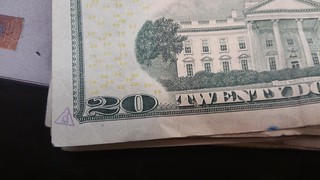
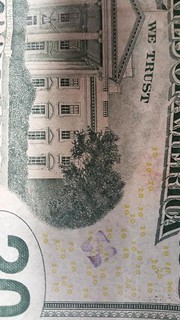
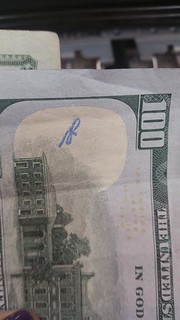
To read the earlier E-Sylum article, see:
CHOPMARKS ON MODERN U.S. PAPER MONEY
(www.coinbooks.org/esylum_v17n07a21.html)
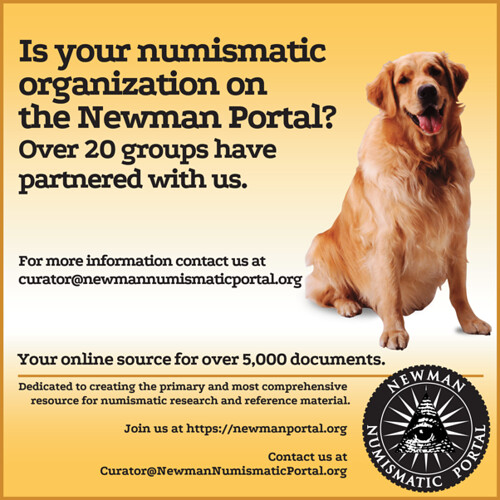
MILITARY MONEY FROM TNE 2016 VALKENBURG FAIR
My first stop was with UK dealer Ian Gradon where I found a nice example of a Thai 20 baht (P41) from the so called Map Series issued under Japanese intervention.
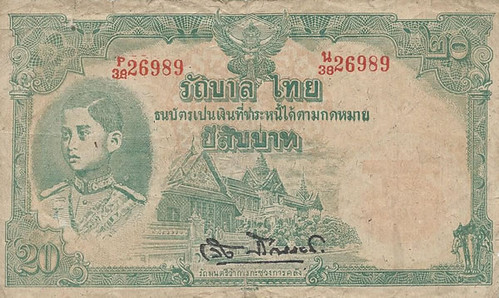
Another walk took me to Ian Marshall’s table where he had some French lottery tickets, issued to aid prisoners and their families. They are quite colorful as you see.
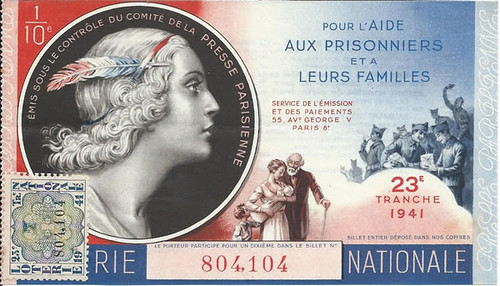
When I returned to the table I met with British dealer Simon Narbeth who showed me a Fanning Island note. This example was complete and which had a stamp on the back which read: “FANNING ISLAND PLANTATIONS LTD”. Handwritten in red was the word “Negotiable” and it was signed by what appears to be R.G. Garrett. I do not have a whole Fanning Island note, only two different halves, and would have loved to add this one to the other two pieces. Alas, the budget got in the way again and I had to pass. Simon did permit me to photograph the note so I guess I have to be happy with the pictures.
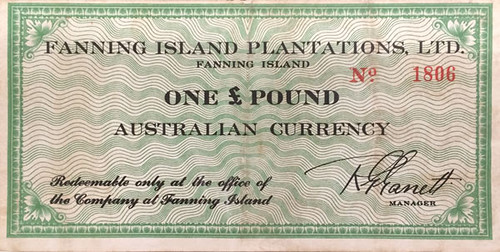
The serial number, by the way, is not recorded in SB.
It is only in Valkenburg that I see Australian dealer Trevor Wilkin and he always has a nice selection of military notes. I’m not always in a position to buy some, but on this trip, two pieces came my way. The first is a 100 franc Marianne piece (Caisse Centrale de la France Libre) with no overprint.
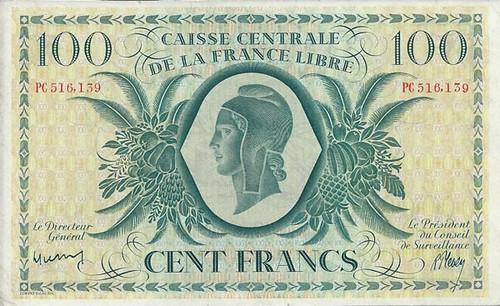
The note is identified as SB 1184 making it an issue for French Equatorial Africa.
To read the complete issue, see:
MPC Gram Spring 2016
(http://us13.campaign-archive2.com/?u=10eb366ab80344a56657e0d5d&id=916c8a3073&e=f71a788d6b)
STACKS-BOWERS TO AUCTION MAJOR MPC COLLECTION
At the World's Fair of Money (also known as the ANA convention) in Anaheim, Stacks-Bowers Auctions will sell a most remarkable MPC collection.
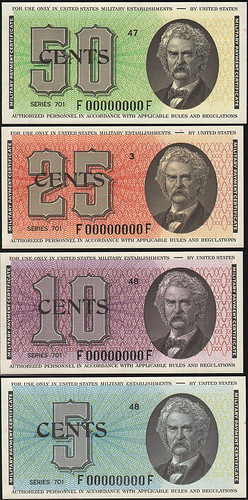
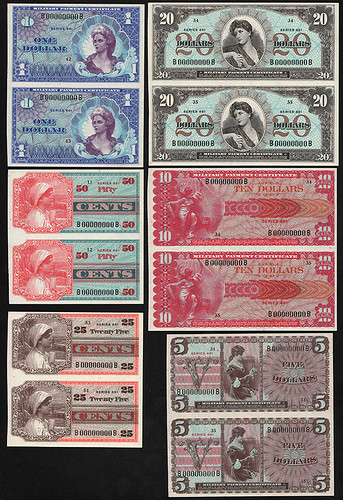
The collection includes regular issue certificates, replacements, and specimens. That seems to cover every category--but it does not. It includes a category that we never before considered! Here are some highlights in each of the categories.
Regular issues: Series 481 $5 apparent fourth printing. Until now collector Dick Freyser was the only one to have one of these notes. It has a serial number that exceeda that of third printings and also has the characteristics of the fourth printing.
Replacements: there are many great replacements in the collection. I will tell you about two. The first is an amazing uncirculated Series 471 $5! Yes, we are talking about replacements here. Indeed, this $5 is part of a full set of Series 471 replacements!
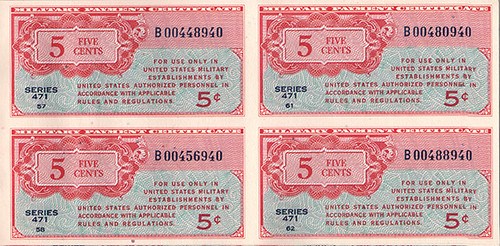
Even if you do not collect MPC by printing, you probably know that Series 521 $5 certificates from the second printing are rare. Heck, only 800,000 regular issue certificates were printed. Only a few are known in collections. Well the piece in this collection is a nice uncirculated second printing replacement--the first such reported (by printing).
Specimens: If you liked the above, you will be amazed at the specimens. They are the strength of the collection. The collection includes specimens in several formats. There are a few partial sets. There are a few double sets--that is cojoined pairs of specimens. Interestingly there is only one specimen set of the classic format with which we are familiar--one specimen of each denomination in a booklet. In this case it is a Series 692 set.
The collection includes two formats of specimens that have not been previously reported. The first is a set of Series 521 with zero serial numbers but no prefixes or suffixes. The other is a Series 591 set with zeros and SPECIMEN hand stamped on each note. Both of these sets are loose (not in booklets).
The PCS book in this collection is of Series 701! Furthermore, it is a complete set of Series 701. Yes, it includes the fractional denominations! This would represent the first opportunity that collectors have ever had to obtain a fractional note or set for a collection, except that I deceived you. Among the specimen sets described above is a full specimen set of Series 701 complete with fractional denominations!
After you get over the shock of this announcement, you will want to know whence came this collection. We do not have detailed information except that it came from a former government employee. I do not know if the person was military or civilian, but he or she received the bulk of the collection as a departing gift upon retirement. The collection was consigned to Stacks-Bowers by an heir after the death of the retiree. I do not know if more details will ever be available.
The auction catalog is certain to be a beauty. It is likely that collectors will be talking about this auction and referring to this catalog for a very long time.
To read the complete article, see:
Save Your Money
(http://us13.campaign-archive2.com/?u=10eb366ab80344a56657e0d5d&id=30e9569f5a&e=f71a788d6b)
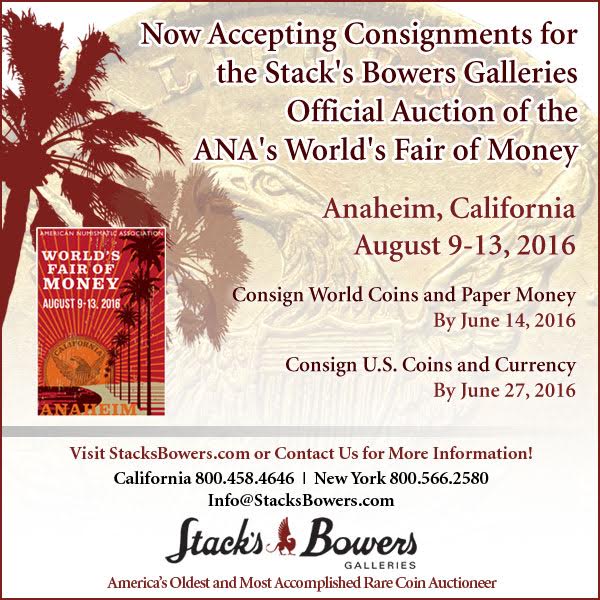
MORE ON COLLECTING ZERO RUPEE NOTES

Zero Rupee Anti-Corruption Note
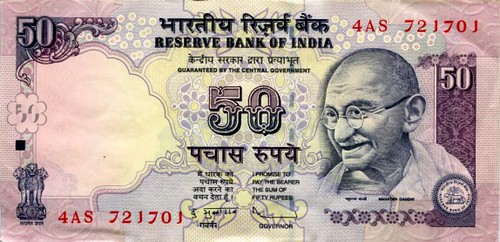
2009 India 50 Rupees Banknote
Bribes, graft and corruption has been is a major issue in India. Citizens are tired of having to pay bribes to government officials in order for them to do their job. Recently a number of anti-corruption groups have been rising up throughout the country. One of these groups, called 5th Pillar, issued these Zero Rupee anti-corruption notes.
The front of the note is modeled after the 50 Rupee note, which is often used for small bribes. The back provides information about the organization and its goals in Hindi and English. The idea is to embarrass government officials that ask for bribes by giving them one of these anti-corruption notes.
The notes have been distributed throughout India and the program appears to be getting some positive results. It has won international acclaim and is spawning imitators in other nations with a problem with corruption.
We offer both the Zero Rupee note and the real 50 Rupee note upon which it was modeled. Both feature Mahatma Gandhi.
For more information, or to order, see:
COINS OF INDIA, PAKISTAN, BANGLADESH, NEPAL &BHUTAN : ZERO RUPEE ANTI-CORRUPTION NOTE FROM
INDIA (www.joelscoins.com/india.htm)
To read the earlier E-Sylum articles, see:
THE ZERO RUPEE ANTI-CORRUPTION NOTE (www.coinbooks.org/esylum_v19n21a36.html)
NOTES FROM E-SYLUM READERS: MAY 29, 2016 : Collecting Zero Rupee Notes
(www.coinbooks.org/esylum_v19n22a09.html)
SWEDEN LEADS RACE TO CASHLESS SOCIETY
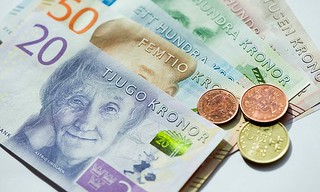 In 1661, Stockholms Banco, the precursor to the Swedish central bank, issued Europe’s first banknotes, on thick watermarked paper bearing
the bank’s seal and eight handwritten signatures.
In 1661, Stockholms Banco, the precursor to the Swedish central bank, issued Europe’s first banknotes, on thick watermarked paper bearing
the bank’s seal and eight handwritten signatures.
Last year – as Britain did last week – Sweden launched a new series of notes, cheery affairs featuring 20th-century Swedish cultural giants such as Astrid Lindgren, the creator of Pippi Longstocking, Greta Garbo and filmmaker Ingmar Bergman. But like its Nordic neighbours Norway, Denmark and Finland, Sweden is fast becoming an almost entirely cashless society.
“I don’t use cash any more, for anything,” said Louise Henriksson, 26, a teaching assistant. “You just don’t need it. Shops don’t want it; lots of banks don’t even have it. Even for a candy bar or a paper, you use a card or phone.”
Swedish buses have not taken cash for years, it is impossible to buy a ticket on the Stockholm metro with cash, retailers are legally entitled to refuse coins and notes, and street vendors – and even churches – increasingly prefer card or phone payments.
According to central bank the Riksbank, cash transactions made up barely 2% of the value of all payments made in Sweden last year – a figure some see dropping to 0.5% by 2020. In shops, cash is now used for barely 20% of transactions, half the number five years ago, and way below the global average of 75%.
And astonishingly, about 900 of Sweden’s 1,600 bank branches no longer keep cash on hand or take cash deposits – and many, especially in rural areas, no longer have ATMs. Circulation of Swedish krona has fallen from around 106bn in 2009 to 80bn last year.
“I think, in practice, Sweden will pretty much be a cashless society within about five years,” said Niklas Arvidsson, an associate professor specialising in payment systems innovation at Stockholm’s Royal Institute of Technology (KTH).
Arvidsson argues that the country’s head start in the field began in the 1960s, when banks persuaded employers and workers to use digital bank transfers for wages as a matter of course, with credit and debit cards receiving a boost in the 1990s when Sweden’s banks started charging for cheques.
Cards are now the main form of payment: according to Visa, Swedes use them more than three times as often as the average European, making an average of 207 payments per card in 2015.
More recently, mobile phone apps have also taken off in spectacular fashion.
Even Swedish churches have adapted, displaying their phone numbers at the end of each service and asking parishioners to use Swish to drop their contribution into the virtual Sunday collection. One Stockholm church said last year only 15% of its donations were in cash; the remainder were all by phone.
There are, obviously, concerns: cases of electronic fraud have more than doubled in the past decade and several critics – including the inventor of iZettle, Jacob de Greer – have asked whether an entirely electronic system in which every single payment is recorded is not a threat to privacy.
For these and other social reasons, Arvidsson said, cash is not dead quite yet. “Even if, in the next few years, Swedes use almost no cash at all, going 100% cashless needs a political decision,” he said.“The idea of cash, even in Sweden, remains very strong.”
To read the complete article, see:
Sweden leads the race to
become cashless society (www.theguardian.com/business/2016/jun/04/sweden-cashless-society-cards-phone-apps-leading-europe)

MIRROR-FILLED BOOKSTORE SEEMS NEVER-ENDING
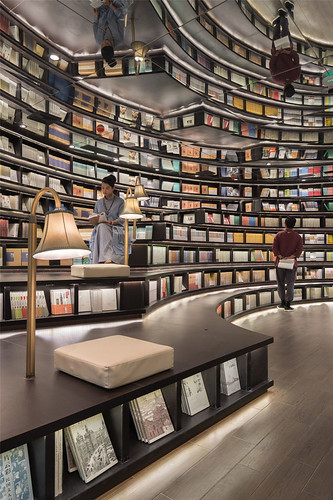
A new bookstore has recently opened in Hangzhou, China, and the inside is kind of amazing to see.
The store is located just above the main plaza, within the commercial center of Star Avenue, in the Binjiang District, and adjacent to Qiantang River.
The bookstore, designed by XL-MUSE, has been designed so the spaces seem huge and never-ending.
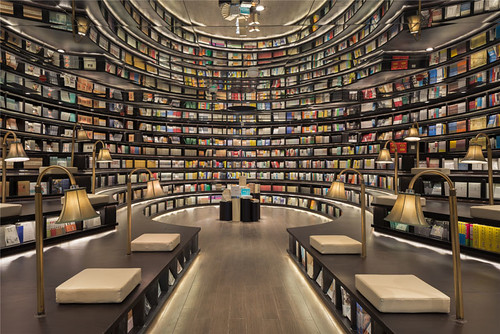

To read the complete article, see:
This Unique New Bookstore Is
Filled With Optical Illusions (http://www.contemporist.com/2016/05/20/this-unique-new-bookstore-is-filled-with-optical-illusions/)
FEATURED WEB PAGE: COINS OF THOMAS SPENCE
This week's Featured Web Page is on The Propaganda Coins of Thomas Spence and his Contemporaries, on the site of the Fitzwilliam Museum numismatic department.At various points in British history the supply of official money issued by the state has become sufficiently scant that unofficial coinage has entered circulation. This has applied especially to small-value coins, in whose manufacture there is little profit for the state and which the government does not need for its own expenditure. For the common working man, however, the absence of lesser denominations made simple transactions very difficult. For example, if he was paid fifteen silver shillings a week, but wished to buy bread worth three halfpence, his coins were each worth much more, and the shopkeeper would not easily be able to refund the difference as change. Particular periods of such change shortage were the years around the English Civil War and the French Revolutionary and Napoleonic Wars, and both generated a substantial 'token' coinage of lesser denominations to supply the want, which are now highly collectable and of great historical interest.
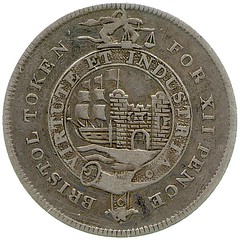
www.fitzmuseum.cam.ac.uk/dept/coins/
exhibitions/spence/

